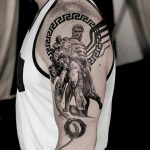Tattoos have been a form of self-expression for millennia, serving as amulets, status symbols, declarations of love, signs of religious beliefs, and even forms of punishment. Within this rich tapestry, Christian tattoos stand out for their deep spiritual significance and profound symbolism. They are more than mere decorations; they are visual testimonies of faith, hope, and a personal narrative of belief etched into the skin.
Biblical Figures and Stories Christian Tattoos
Tattoos inspired by biblical figures and stories stand as profound markers of faith and storytelling. They’re not just tattoos; they’re visual messages and stories that will never go out of style.
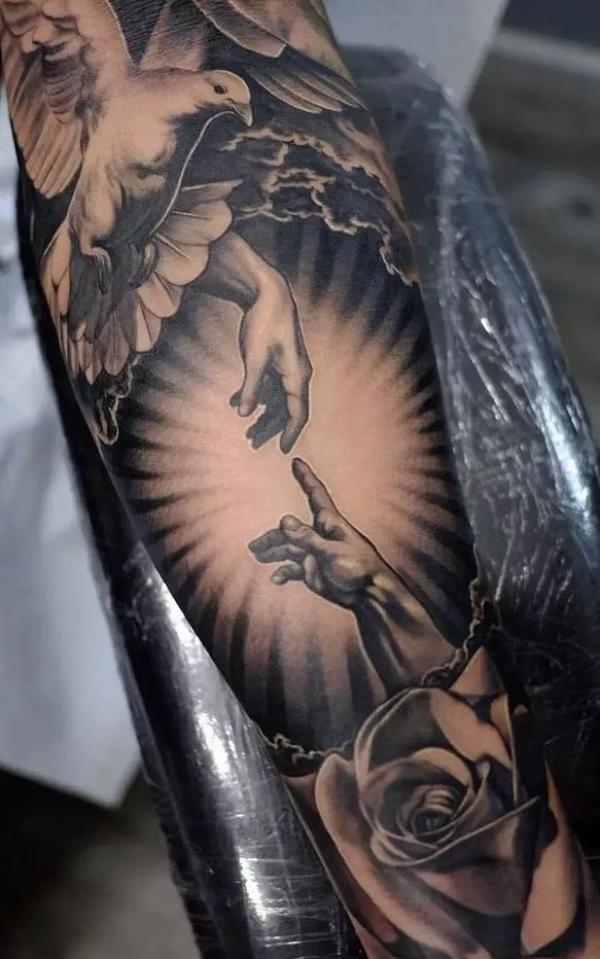
Adam and Eve Christian Tattoo
The story of Adam and Eve is a tale as old as time, representing themes of innocence, temptation, and the fall of man. In the inked world, Adam and Eve tattoos are rich with symbolism. They remind us of where we come from and the shared humanity that began in the Garden of Eden. People get these tattoos to remember the beginning of human history and how complicated our nature is. They often show the famous apple and the snake.
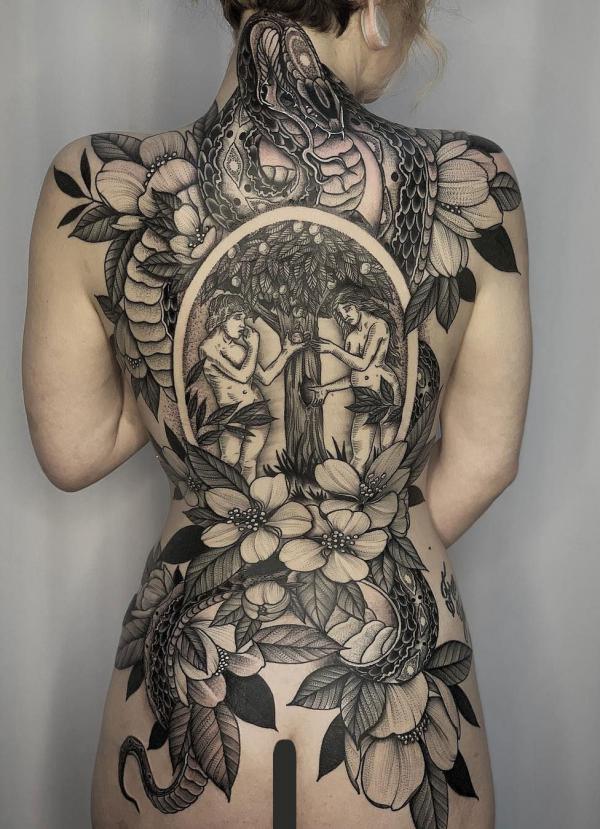
Creation of Adam Christian Tattoo
“Creation of Adam,” which Michelangelo painted on the ceiling of the Sistine Chapel, has become more than just a painting. It now adorns the skin of numerous believers, which make it eternal and honor the divine spark of life. This masterpiece is not just a celebration of human creation but also a reminder of the divine connection between man and God. The near-touching hands of God and Adam symbolize the spark of life, the breath of existence that animates our very being.
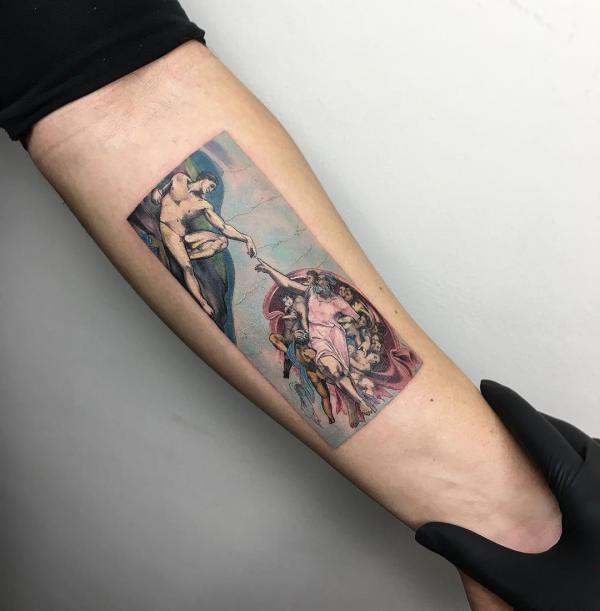
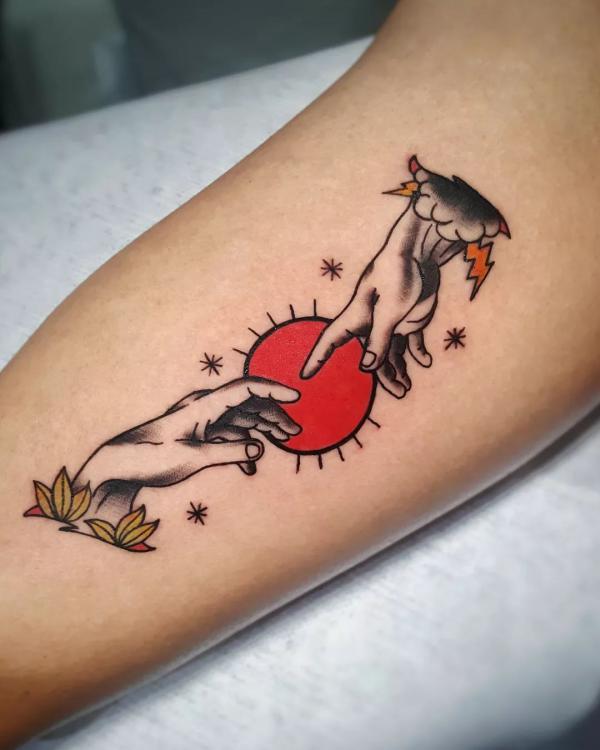
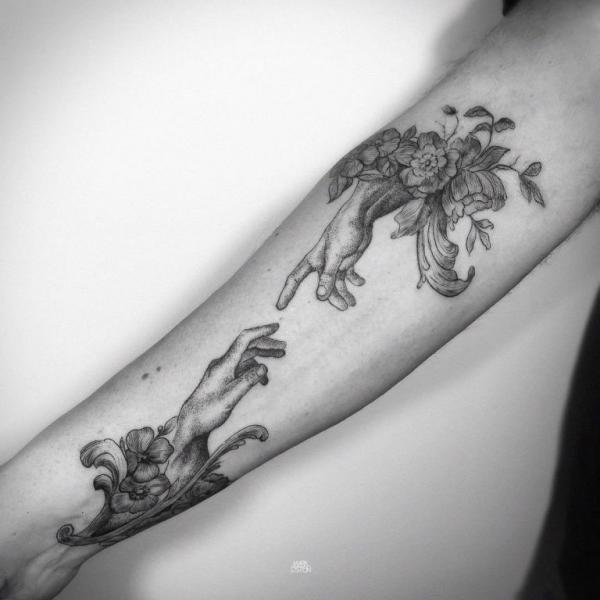
Jesus and Virgin Mary Tattoos
The central figures of Christianity, Jesus Christ and the Virgin Mary, are popular choices for tattoos, encapsulating the core of Christian faith. These tattoos often carry a depth of emotion, from the compassionate gaze of Christ to the motherly love of Mary. Whether it’s the face of Jesus crowned with thorns or the maternal image of Mary cradling her son, these tattoos are powerful expressions of divine love and intercession.
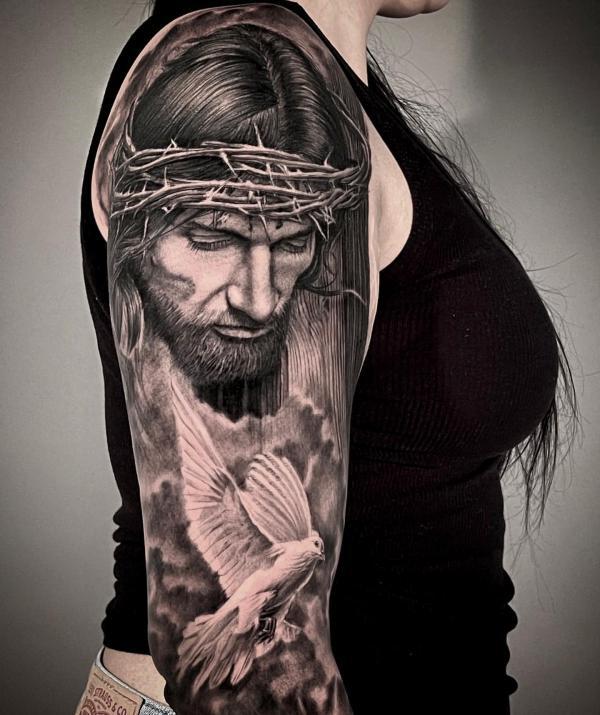
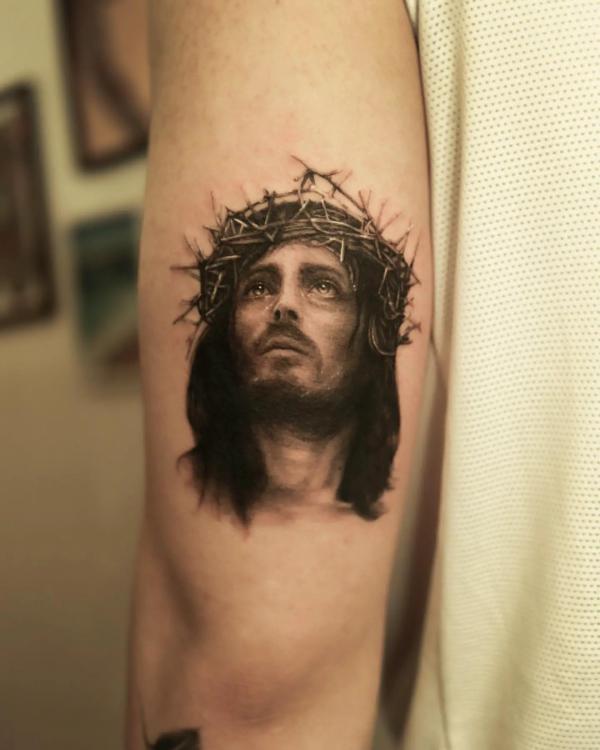
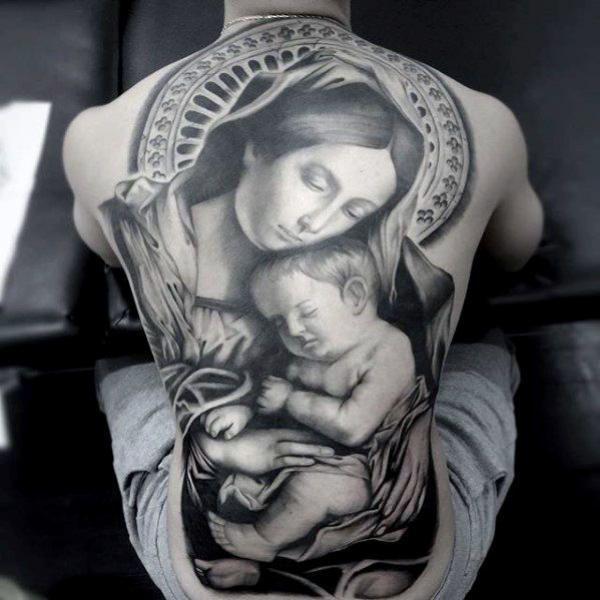
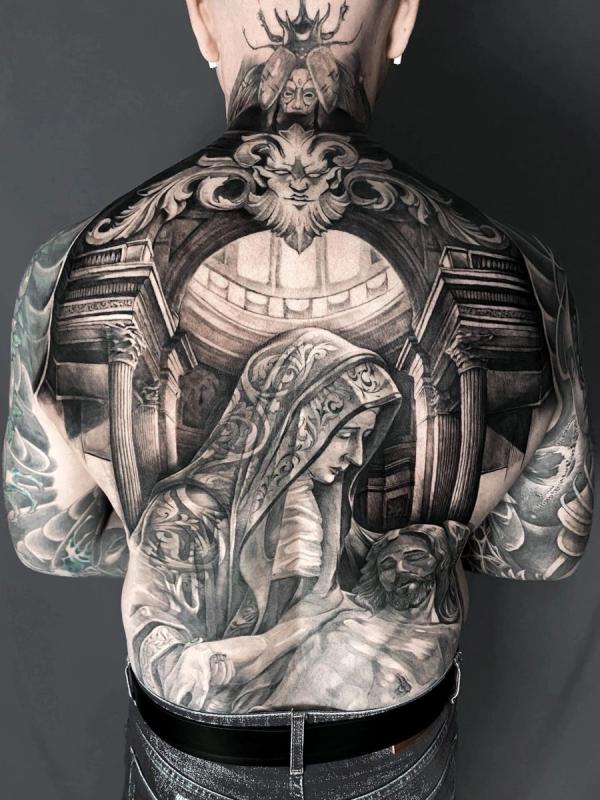
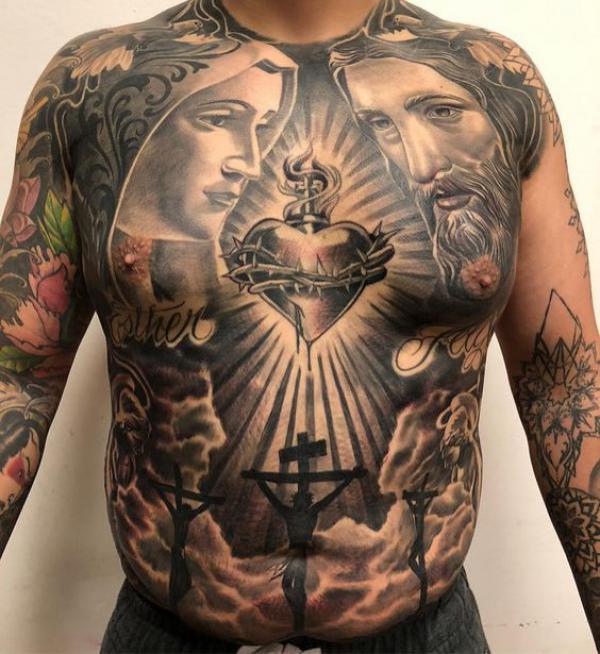
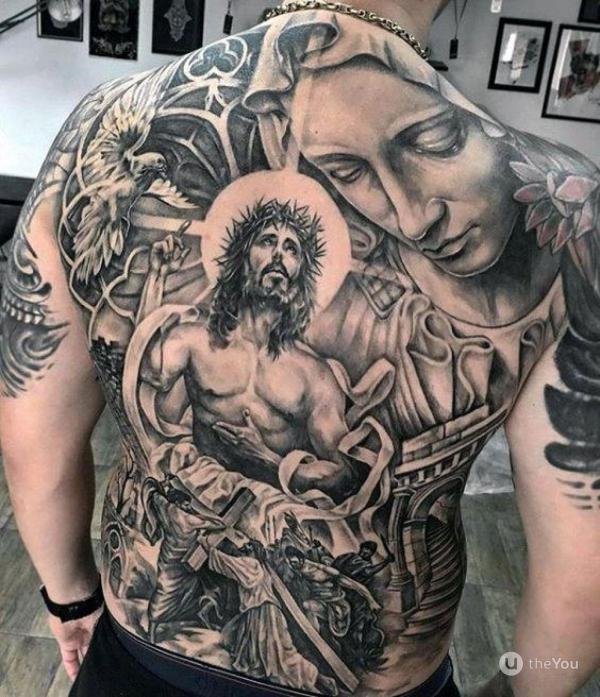
Jesus Shepherd Tattoos
The representation of Jesus as the Good Shepherd is a deeply comforting image for many Christians. It speaks of guidance, protection, and the tender care of Christ for His flock. A Jesus Shepherd tattoo is a symbol of unwavering faith in Jesus’ promise to lead His followers through the valleys and mountains of life.
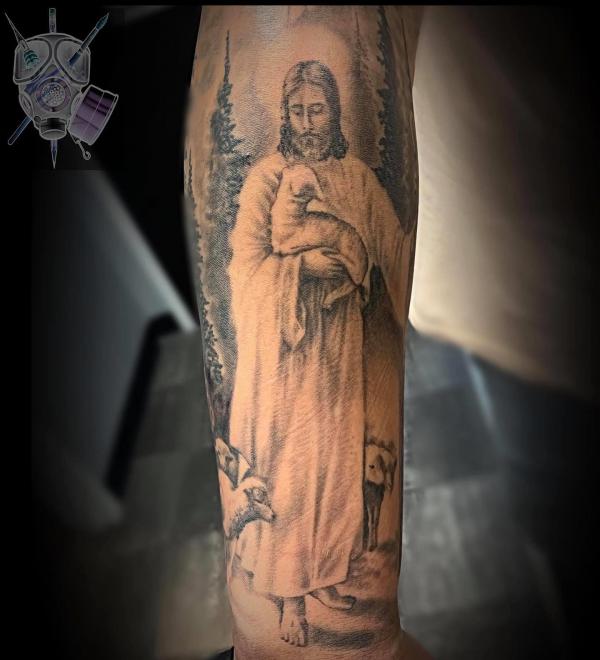
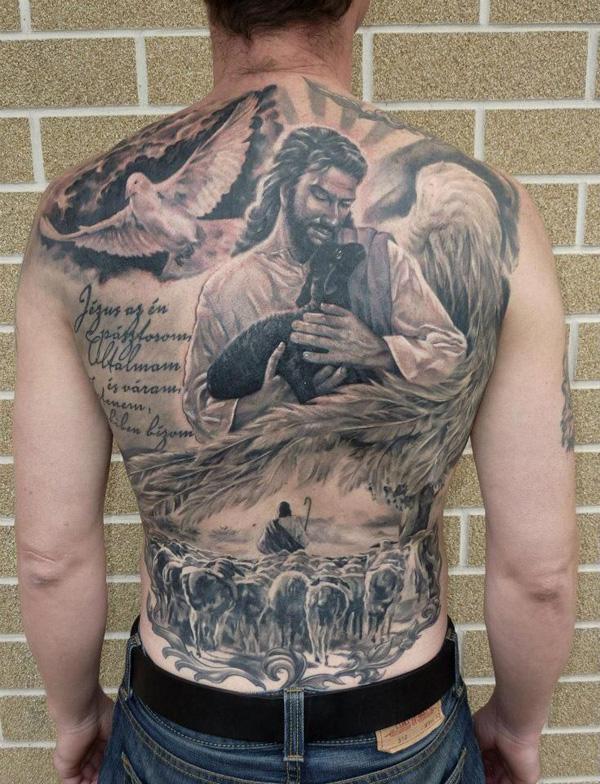
Last Supper Tattoos
The Last Supper, the final meal Jesus shared with His disciples, is a momentous event in the Christian faith, immortalized by Leonardo da Vinci’s renowned painting. As a tattoo, it signifies communion, sacrifice, and the establishment of a covenant between God and humanity. It is a scene that contains layers of meaning, representing betrayal, fellowship, and the foreshadowing of the crucifixion. These tattoos show that the person who has them believes in the Eucharist and understands its deep spiritual meaning.
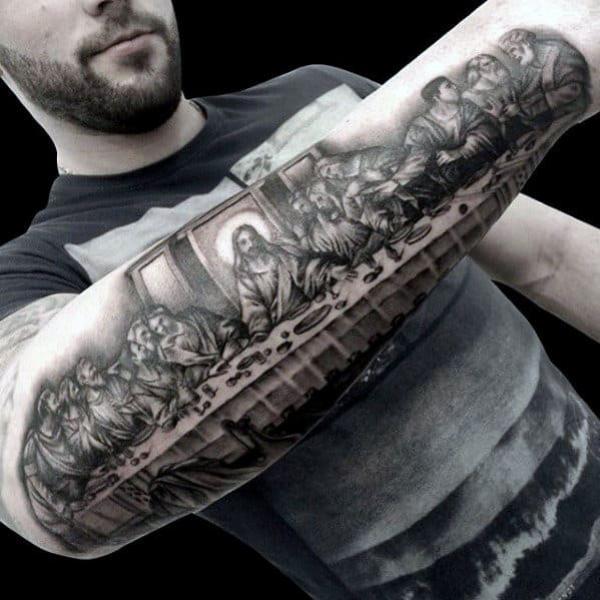
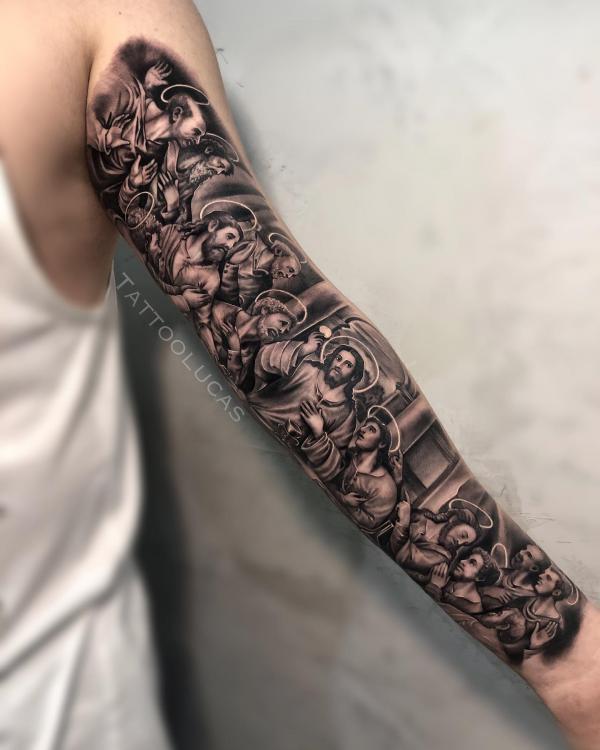
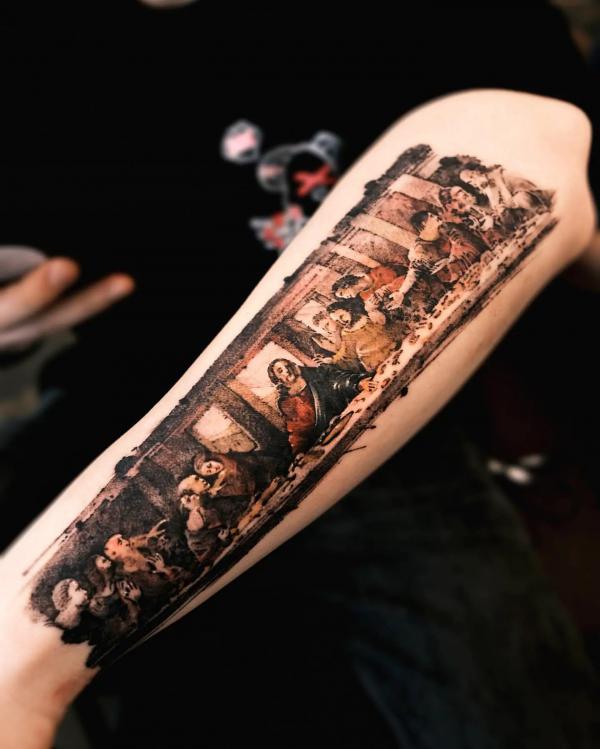
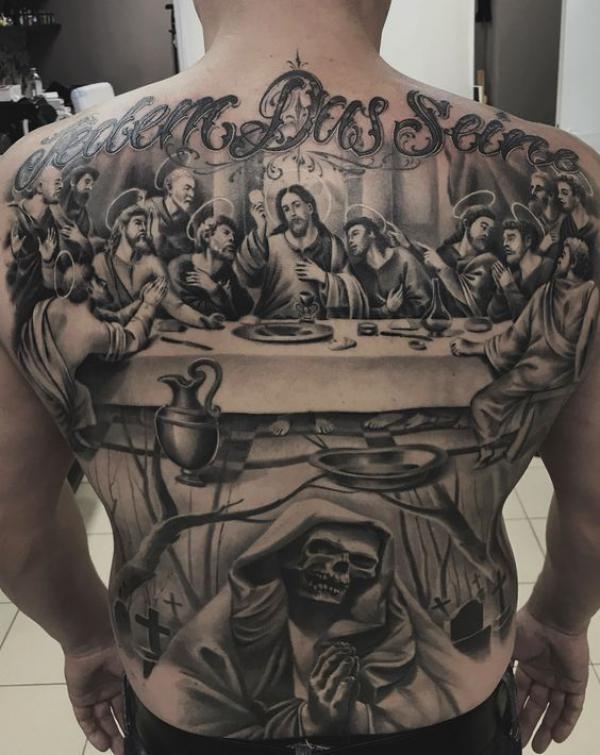
Christian Symbols Tattoo
Despite some denominations having historical reservations about tattoos, the art form has blossomed among Christians seeking to express their faith in a personal way. The Bible itself has been a source of inspiration for designs, with verses from both the Old and New Testaments providing a rich source of imagery.
The Christian faith is replete with symbols, each with its own history and meaning. Let’s explore some of the most significant and popular designs that believers choose to represent their faith through the art of tattooing.
Alpha and Omega Christian Tattoo
The Alpha and Omega are the first and last letters of the Greek alphabet. The symbol is a potent Christian symbol representing God’s omnipresence – the beginning and the end. Ink, they show how long the Almighty has been around and how His presence covers everything. Having these two letters tattooed on your body is a constant sign of your faith in the eternal God.
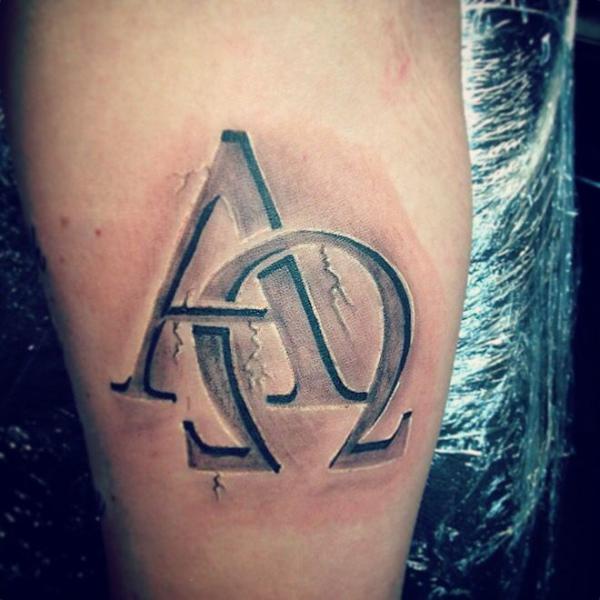
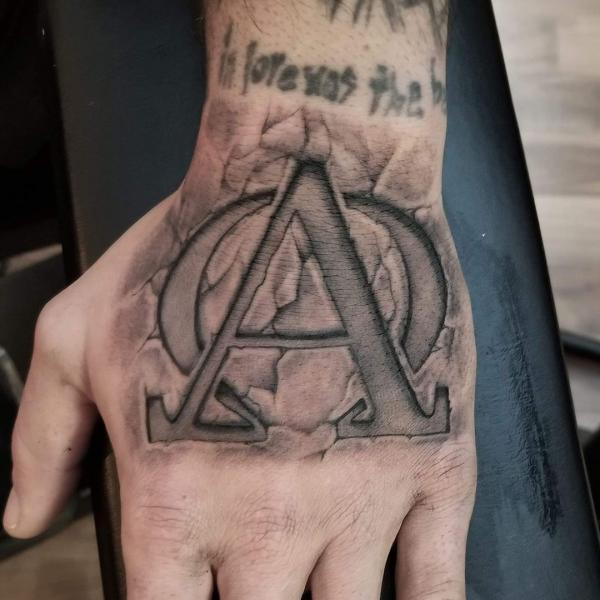
Bible Verse Tattoos
Literature takes on divine reverence when it comes to Bible verse tattoos. These snippets of sacred texts are not just words. They are life verses, guiding principles that wearers carry with them. From the empowering “Philippians 4:13” to the comforting “Psalm 23,” Bible verse tattoos are personal creeds etched in skin. They provide strength and inspiration in every glance.
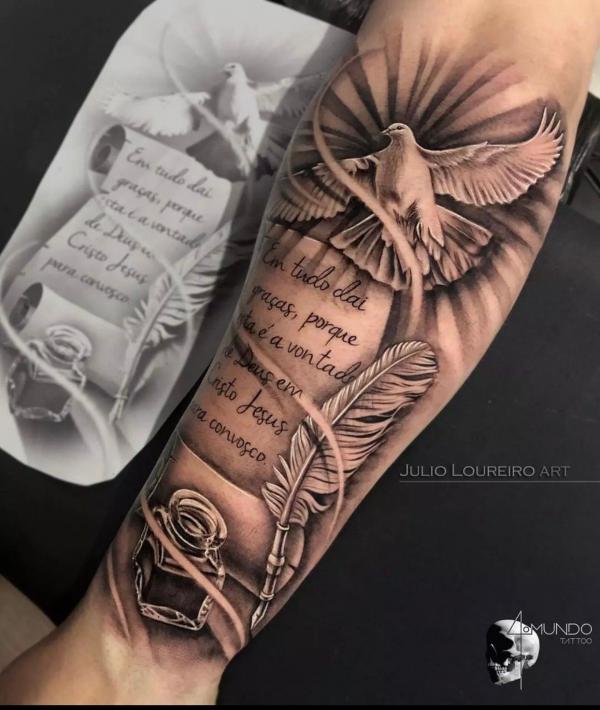
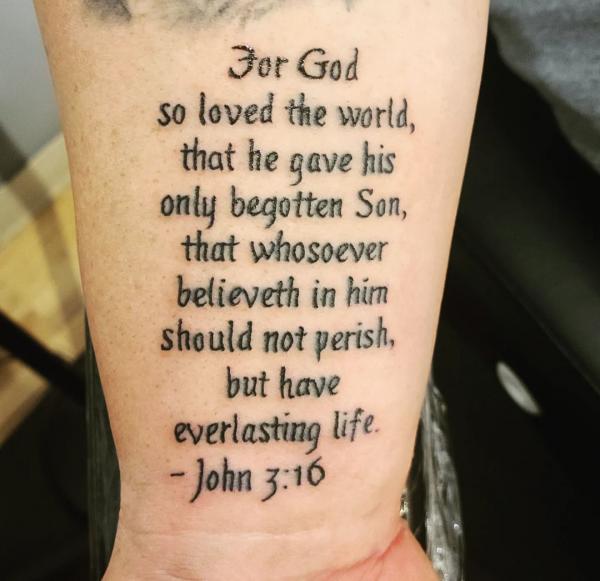
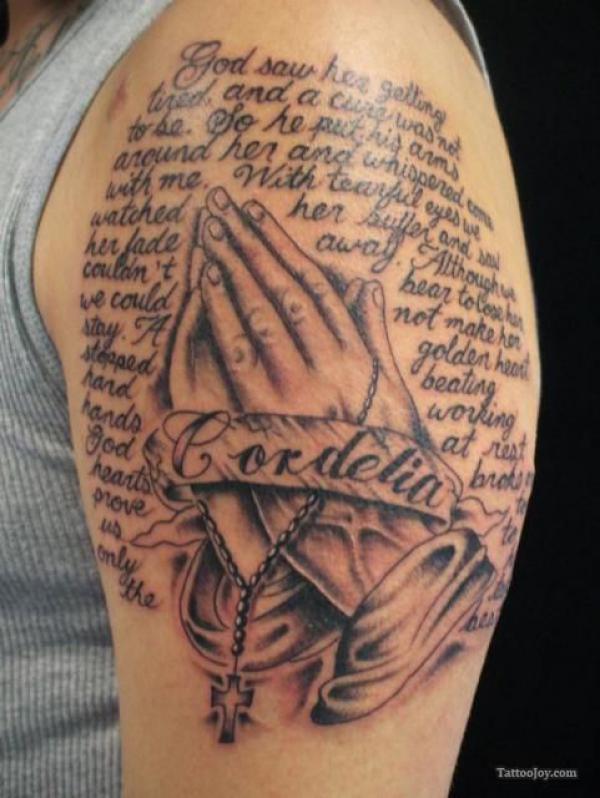
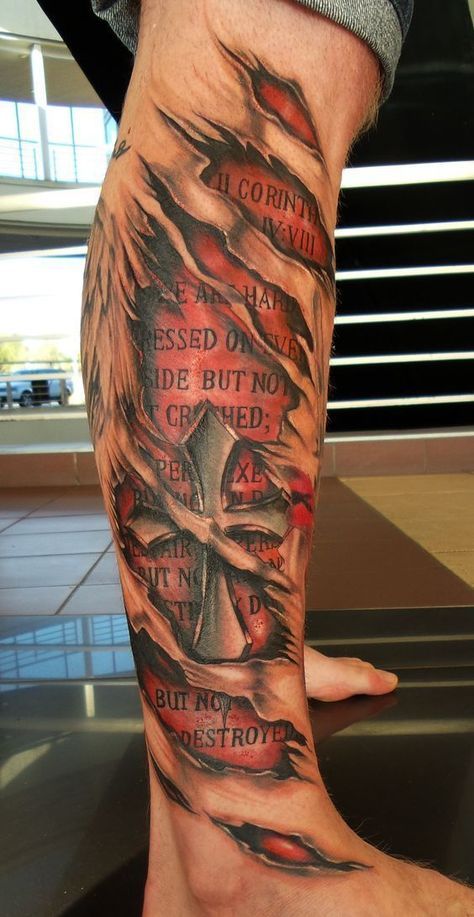
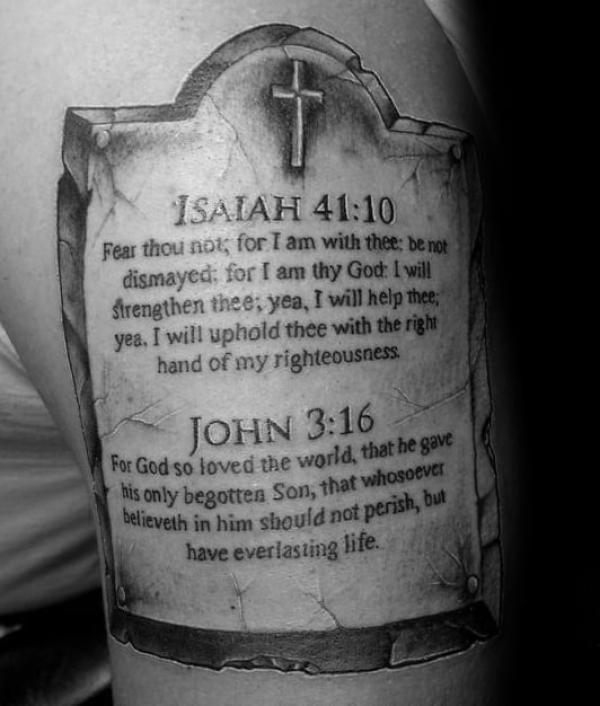
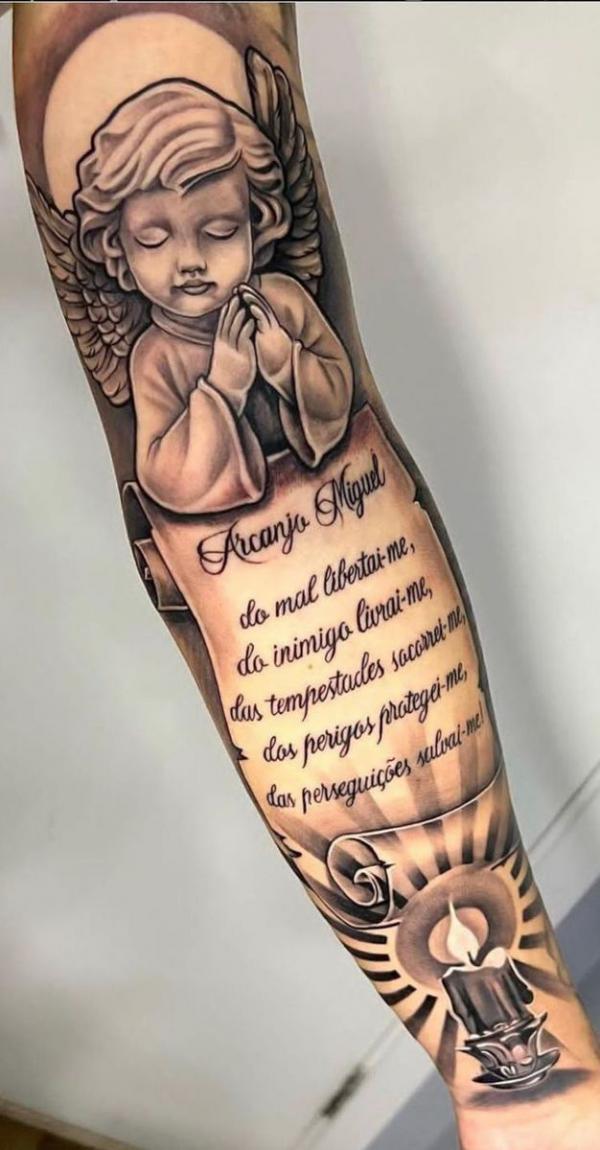
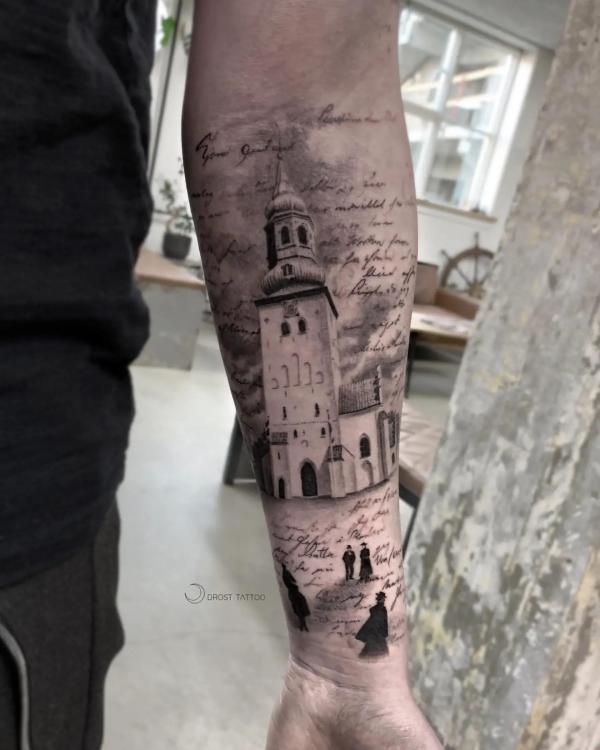
Christian Anchor Tattoos
The anchor, traditionally a symbol of hope and steadfastness, holds a special place in Christian iconography. It is often associated with the verse Hebrews 6:19, which speaks of hope as an anchor for the soul, firm and secure. A Christian anchor tattoo symbolizes unwavering faith and the stability that Christ provides in the tumultuous sea of life. It’s a visual pledge of a soul moored by faith.
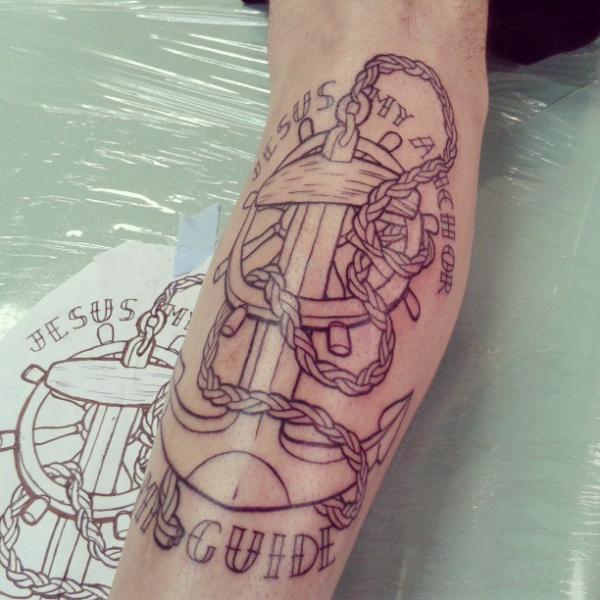
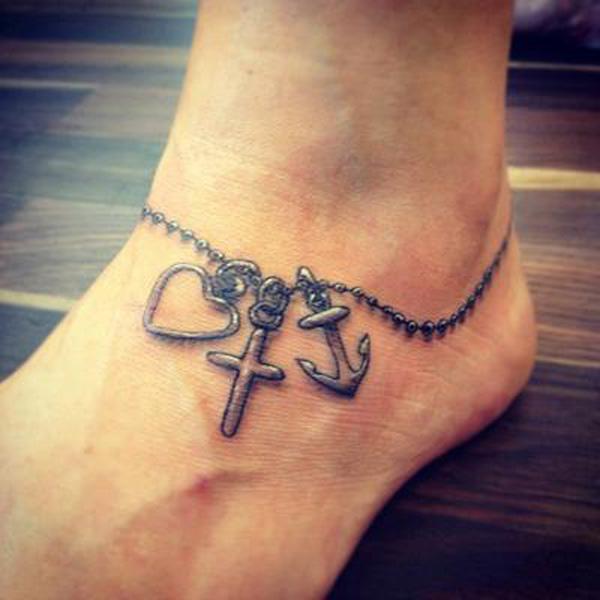
Christian Angel Tattoos
Angels, the messengers of God, are a popular tattoo choice for those who seek to embody divine protection and guidance. Christian angel tattoos often represent guardianship, the holy connection to the divine, and the spiritual oversight everyone craves. Whether depicted in full glory or as a subtle pair of wings, angel tattoos are a celestial nod to the heavenly forces that watch over the faithful.
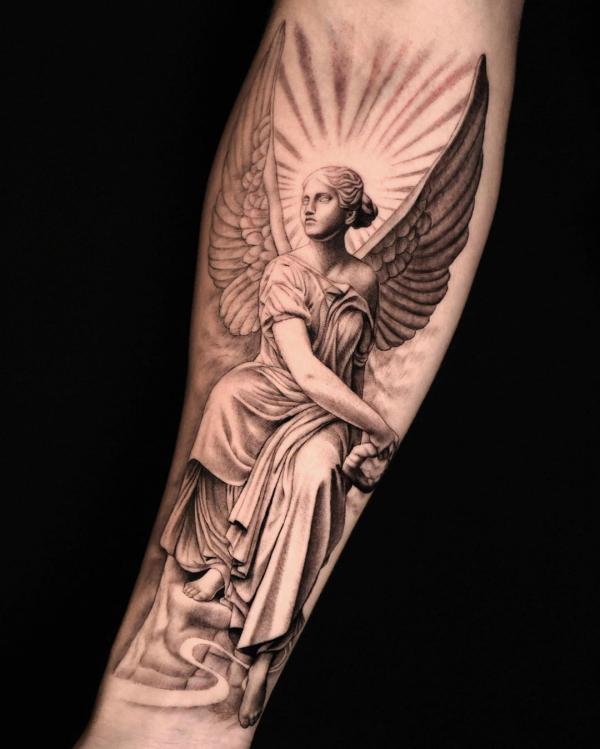
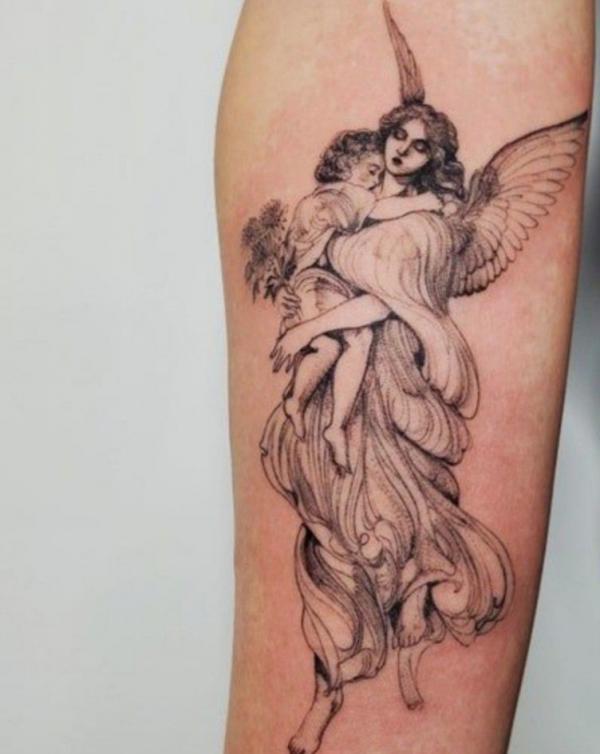
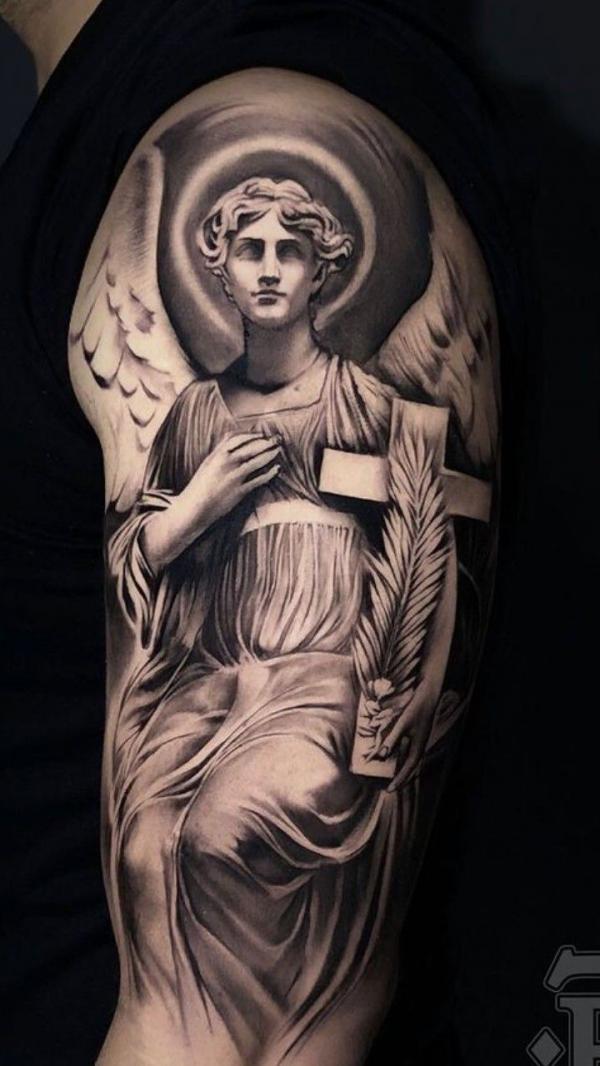
Christian Chi Rho Tattoos
The Chi Rho symbol, an early christogram, emerges from the overlay of the Greek letters Chi (Χ) and Rho (Ρ). These are the initial capitals in the Greek word “ΧΡΙΣΤΟΣ,” which translates to Christ. The resulting monogram intertwines these letters to form a significant emblem of Christian heritage. This tattoo becomes a historical nod to the roots of Christian faith, symbolizing Christ and his reign over the cosmos. It’s a mark of ancient faith, carrying the weight of Christian heritage with every line.
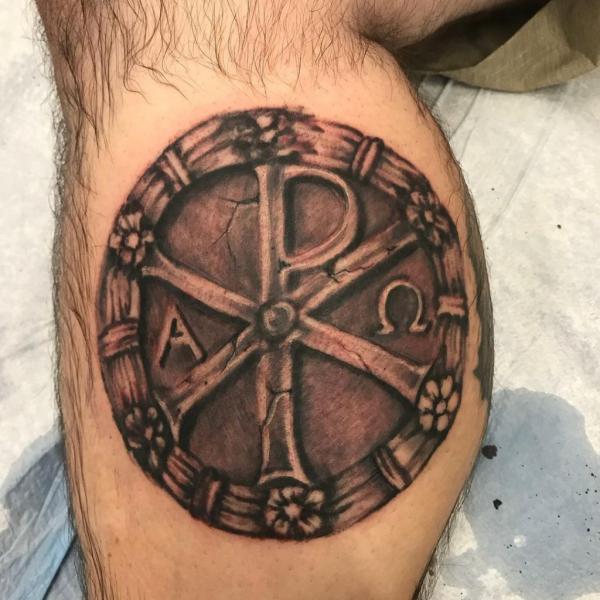
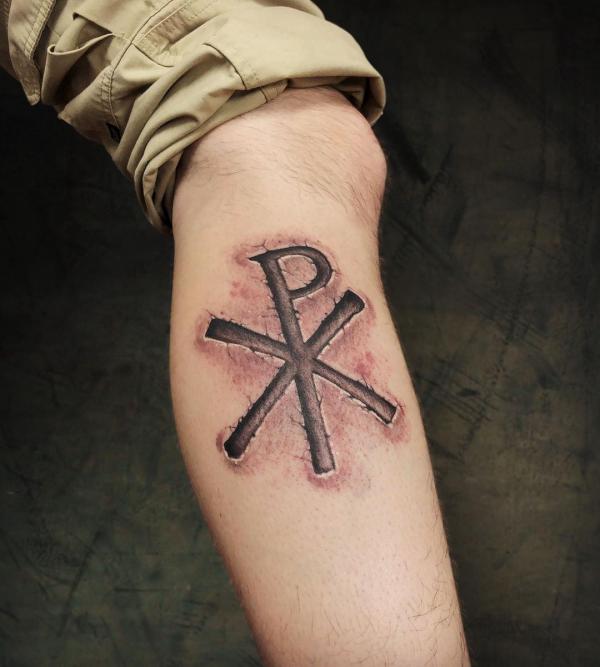
Christian Cross Tattoos
Perhaps the most quintessential of Christian tattoos is the cross. As the principal symbol of the Christian religion, it recalls the Crucifixion of Jesus Christ and the redeeming benefits of his Passion and death. The cross is a sign of both Christ himself and of the faith of Christians. In tattoo form, the cross is a bold declaration of the wearer’s belief in Jesus’ sacrifice and victory over death. Its simplicity is its strength, and its meaning is universal among Christians.
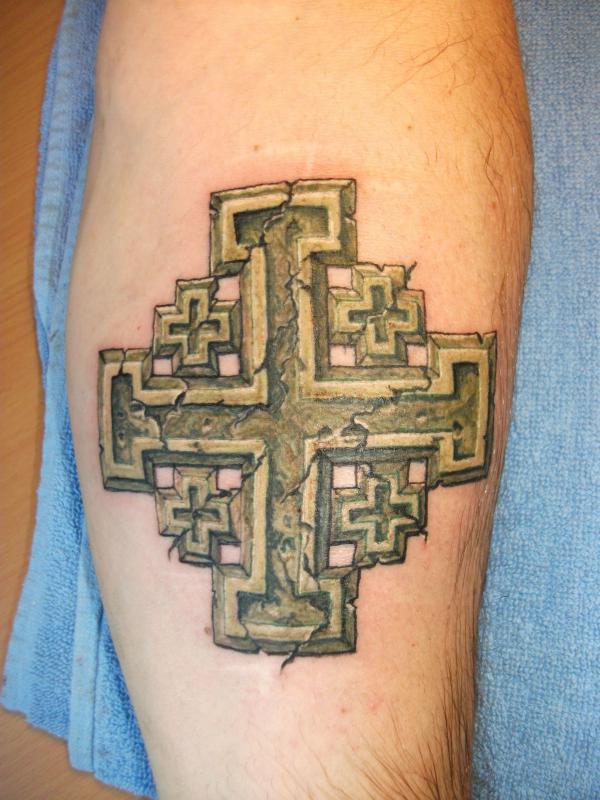
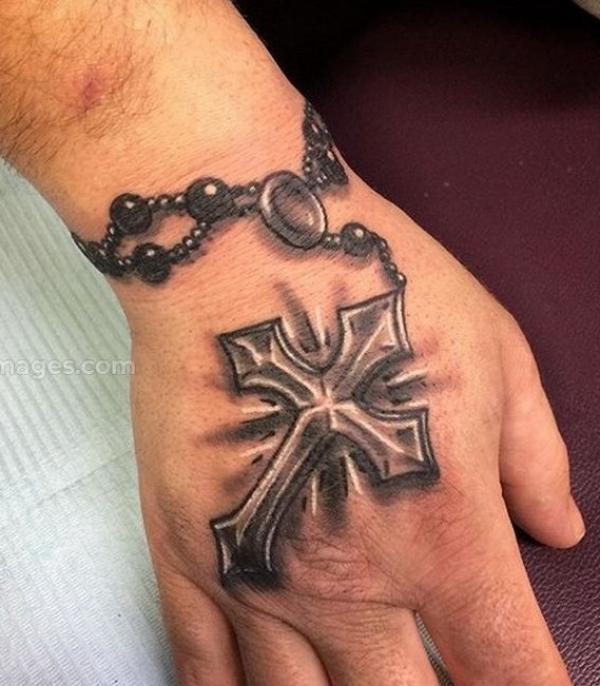
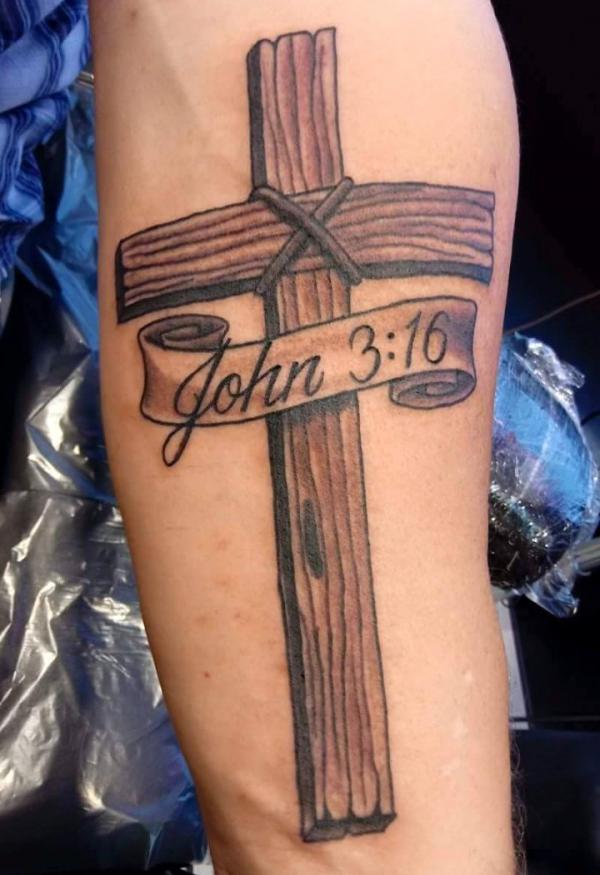
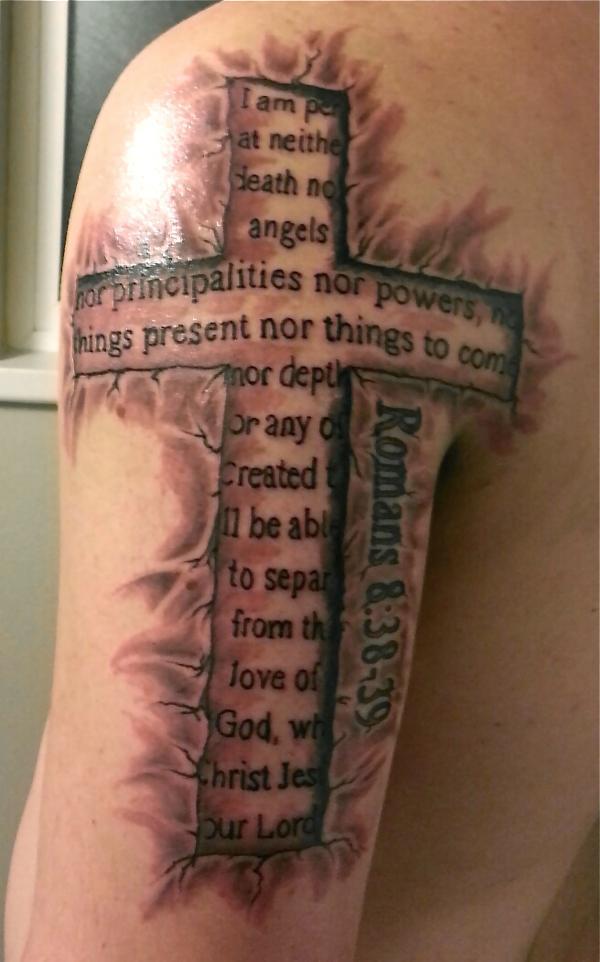
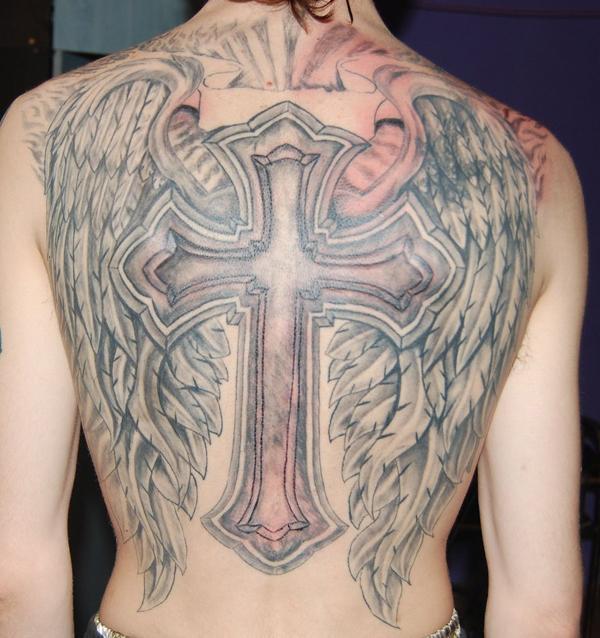
Christian Ichthys Tattoo
The ichthys or fish symbol was used by early Christians as a secret sign during times of persecution. Today, it’s proudly displayed as tattoos, proclaiming one’s faith with a symbol that speaks of Christian tradition and identity. The ichthys tattoo is a subtle yet powerful statement of belief, a nod to the historic roots of Christianity and the call to be ‘fishers of men.’
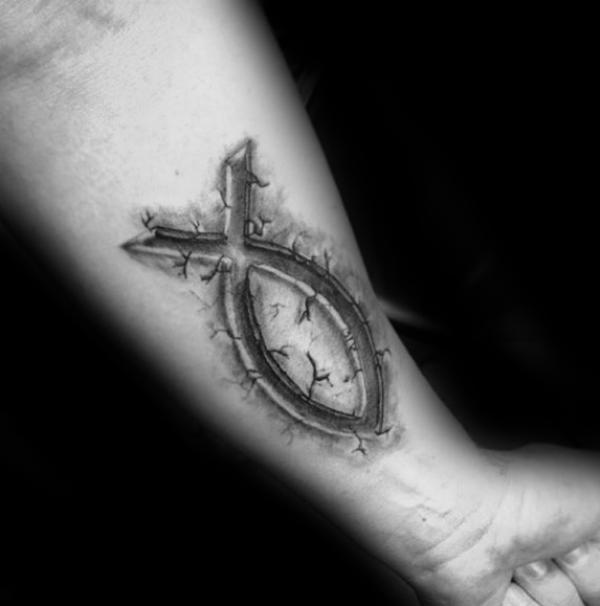

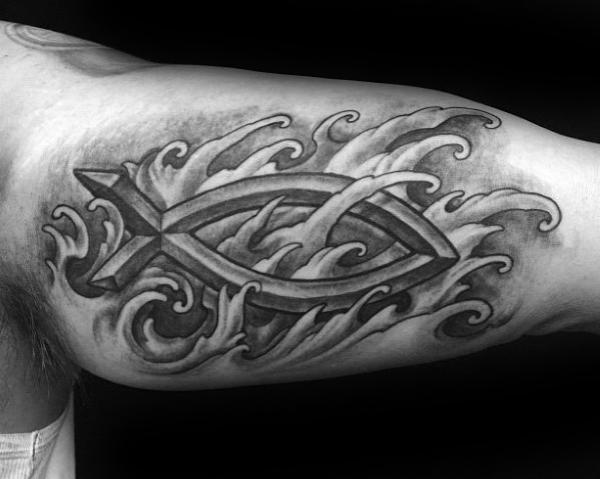
Christian Bible Tattoo
For those who wish to carry the Word of God not just in their hearts but also on their skin, Christian Bible tattoos are a fitting choice. This tattoo can take the form of an open Bible, a hand holding the sacred book, or even a scroll with a verse that has personal significance. These tattoos are daily visual reminders of the wearer’s commitment to their faith and the teachings contained within the holy scriptures.
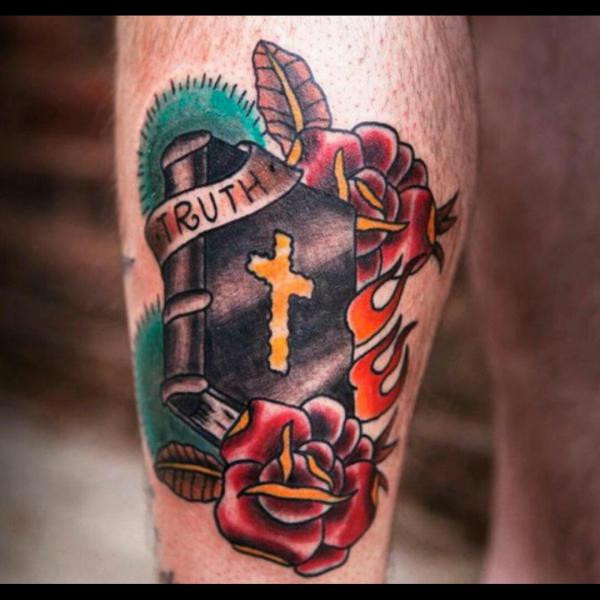
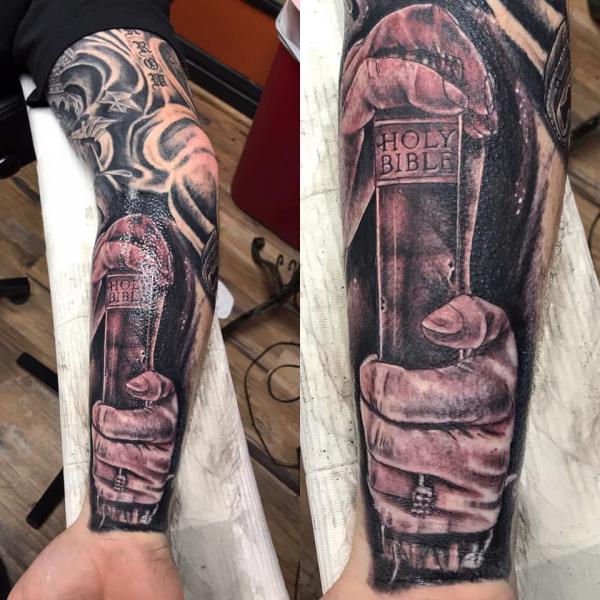
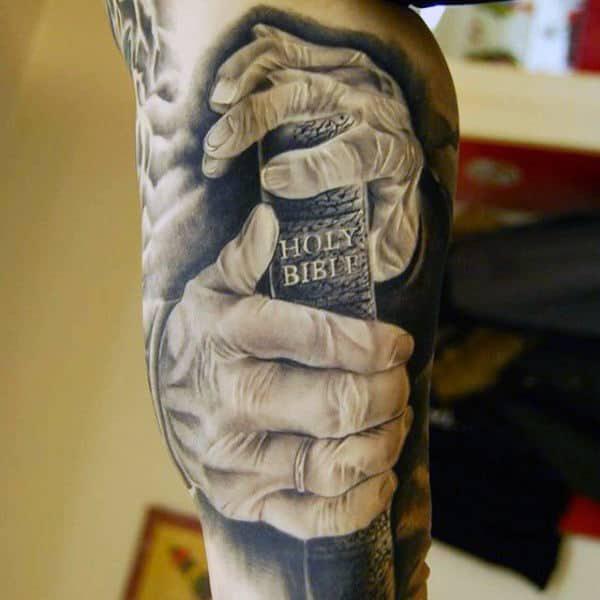
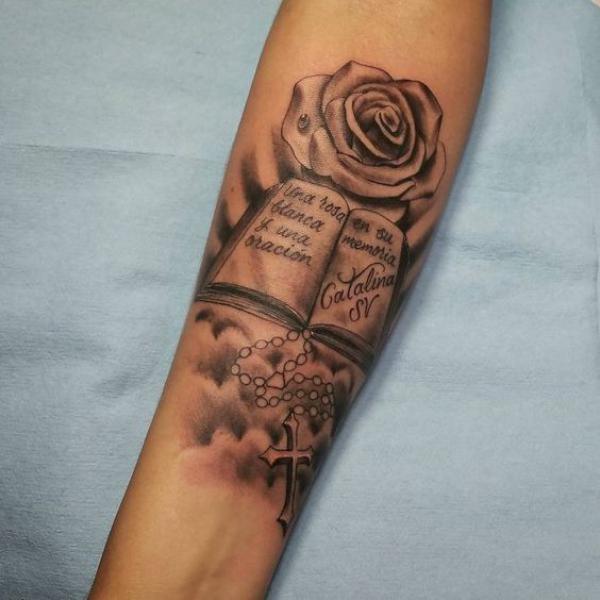
Christian Crucifix Tattoos
A step beyond the cross, the crucifix tattoo adds the figure of Jesus into the symbol, portraying the moment of his sacrifice. This tattoo is a more explicit representation of Christian faith, focusing on the humanity of Christ and his suffering for mankind’s salvation. It’s a powerful and sometimes graphic image that resonates deeply with those who wish to express the profound impact of Christ’s love and sacrifice.
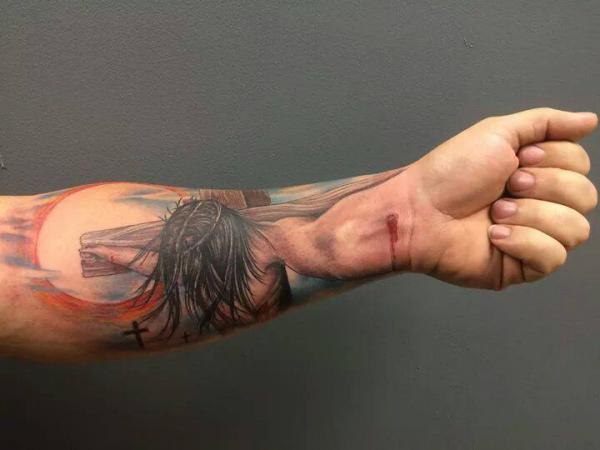
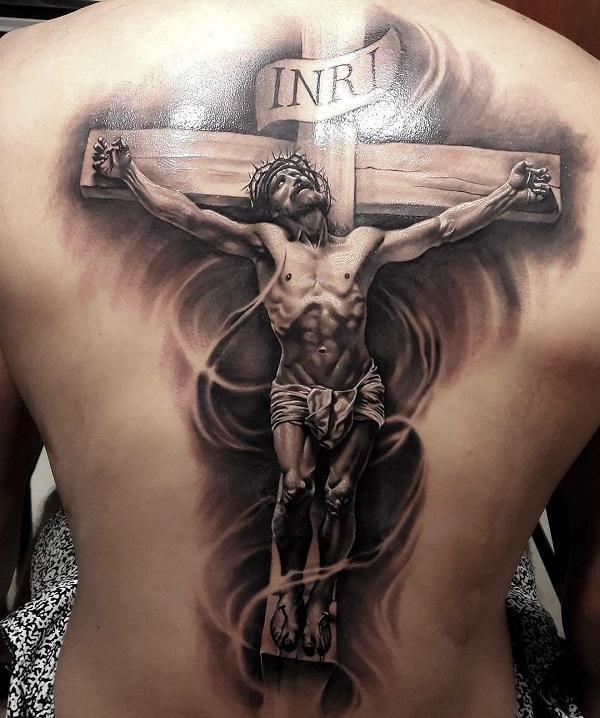
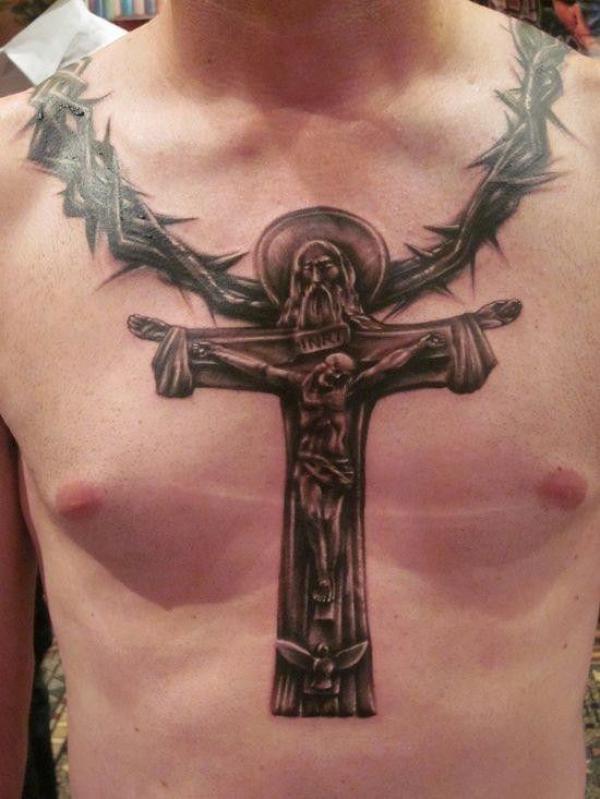
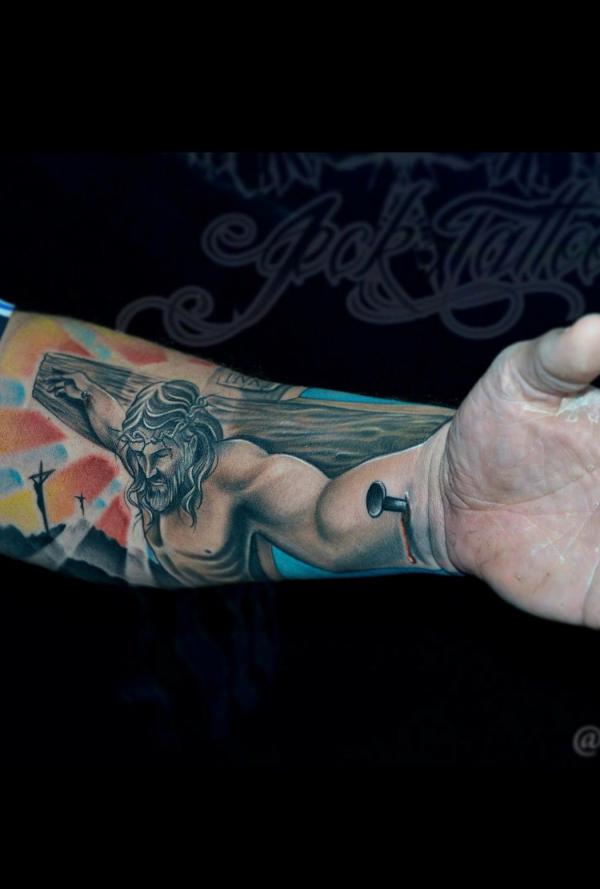
Praying Hands Christian Tattoos
The praying hands tattoo is a humble expression of one’s faith in prayer and reliance on divine guidance. Often accompanied by rosary beads or a cross, this tattoo is a personal sanctuary. It represents the wearer’s spiritual life and constant communication with God. It’s also a symbol of hope, faith, and the power of prayer.
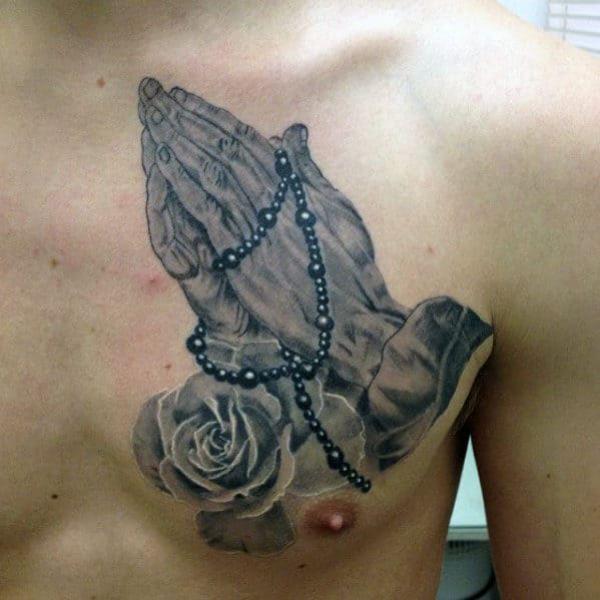
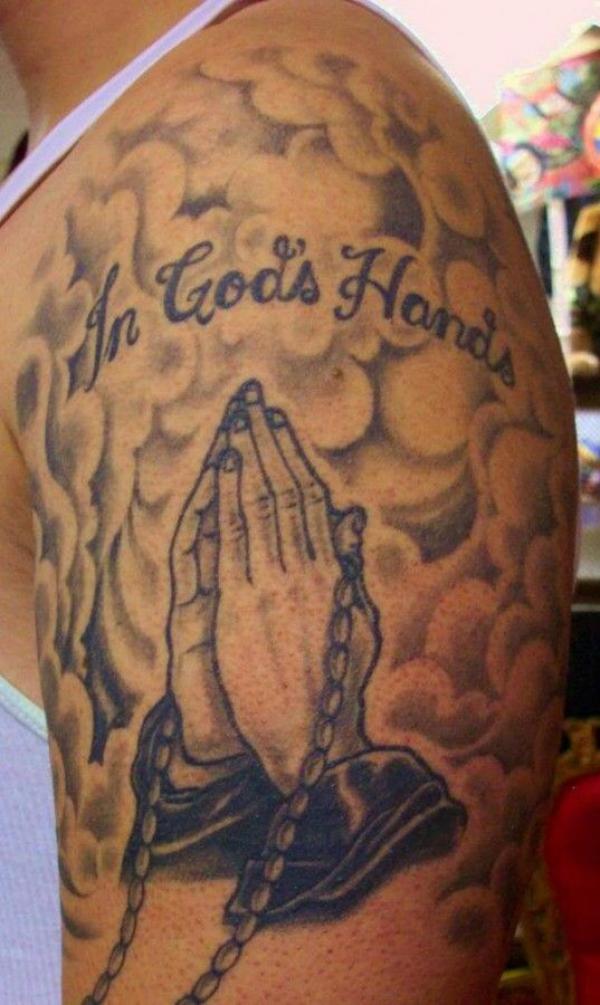
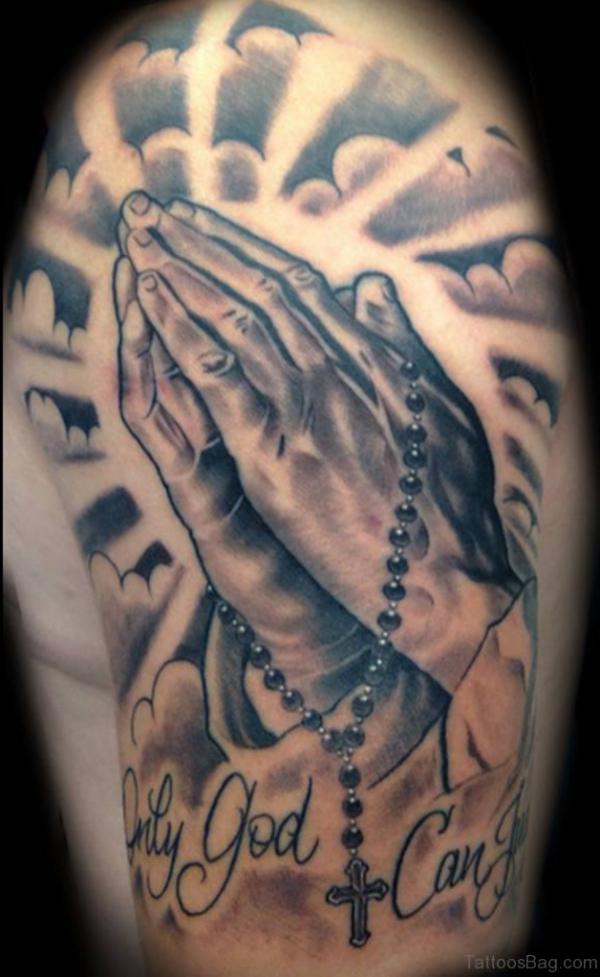
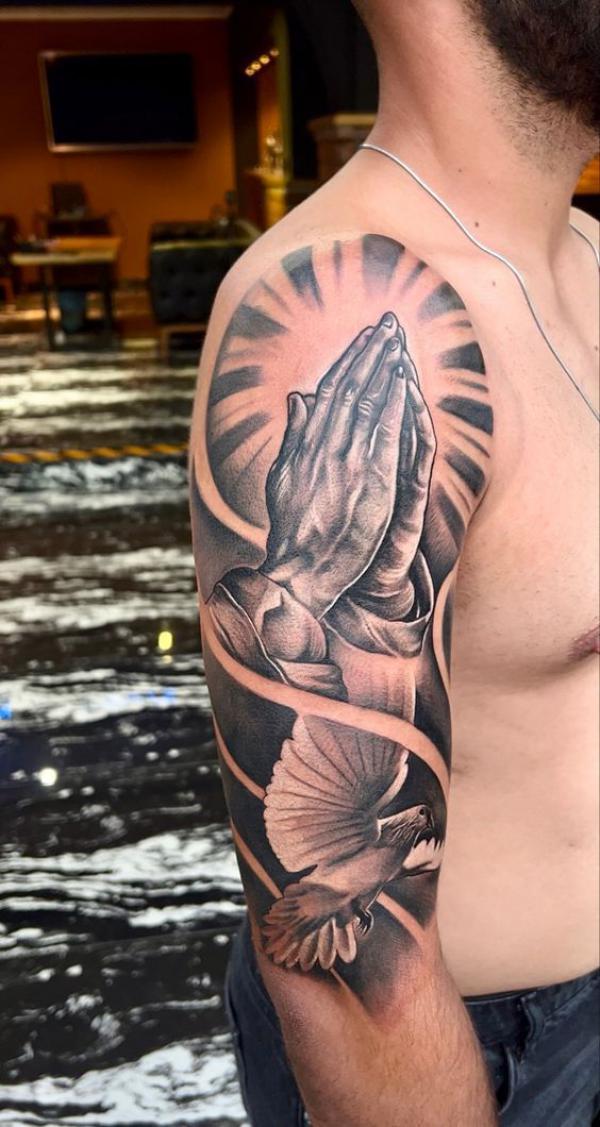
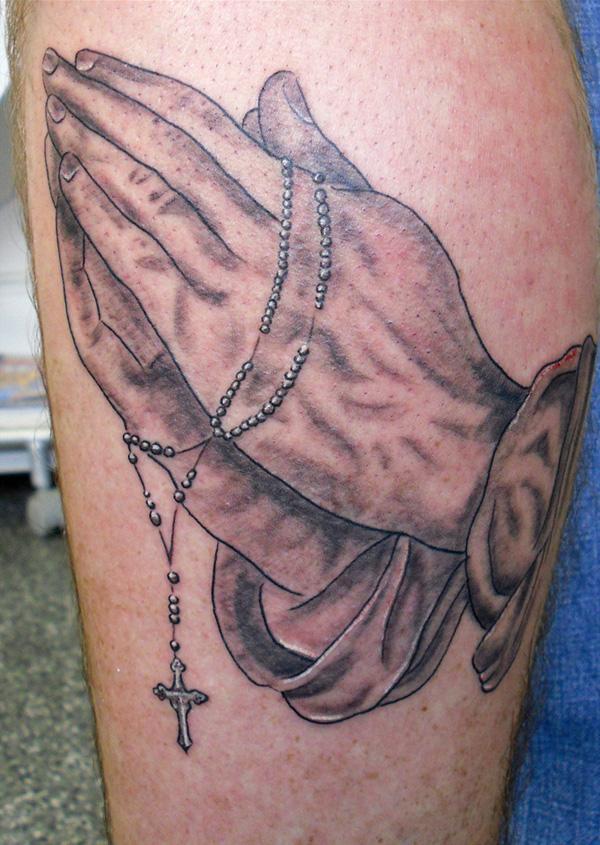
Sacred Heart
Sacred Heart tattoos aren’t just any heart design, they are a profound emblem of unwavering divine love and compassion. Each thorn, each flame, tells a story of redemption, of a love so fierce it endures through pain. And for those who choose to carry this emblem, it’s a daily reminder of the transformative power. The divine love and the light can shine on the darkest parts of our human experience.
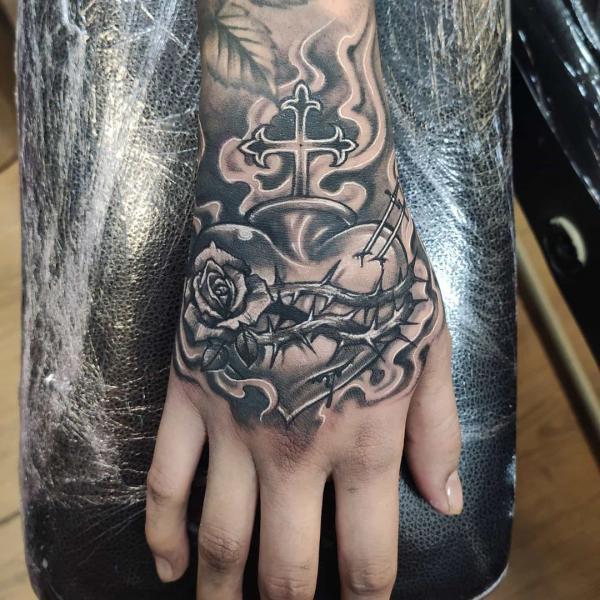
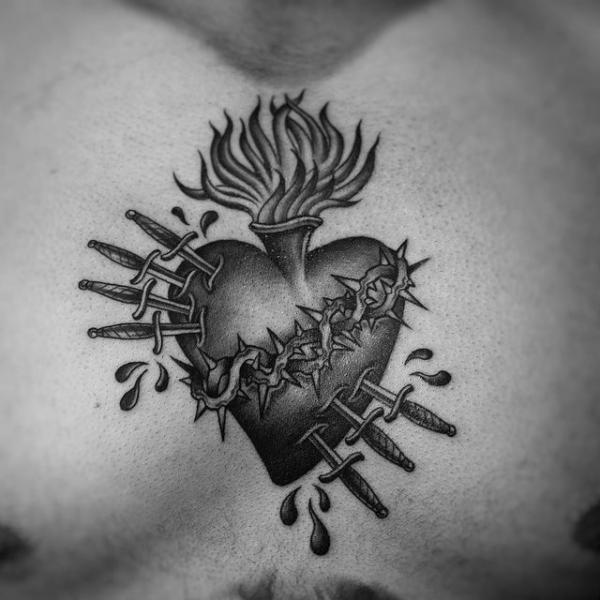
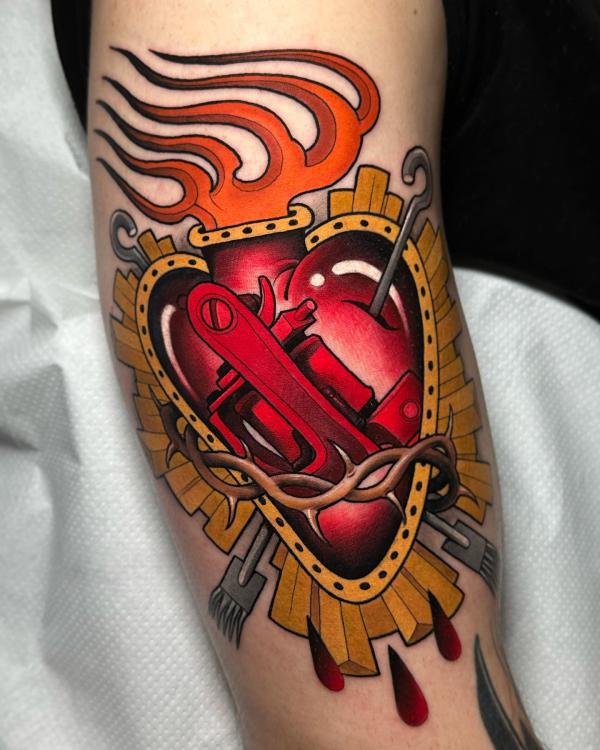
Saint Peter’s Key Tattoos
Moving on to Saint Peter’s Key tattoos—a design steeped in rich biblical symbolism and history. When inked onto the skin, Saint Peter’s Key tattoos are a declaration of the wearer’s commitment to their spiritual journey. They symbolize the unlocking of deeper truths, the entrance to a path of enlightenment, and the trust in divine providence to lead the way. For believers, it’s like carrying your own personal key to the gates of Heaven. These tattoos serve as a constant reminder of the spiritual guardianship granted to Peter and, by extension, to the Church.
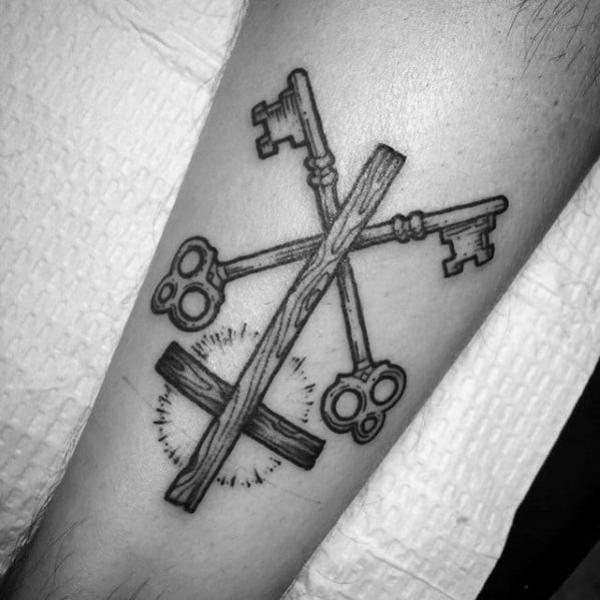
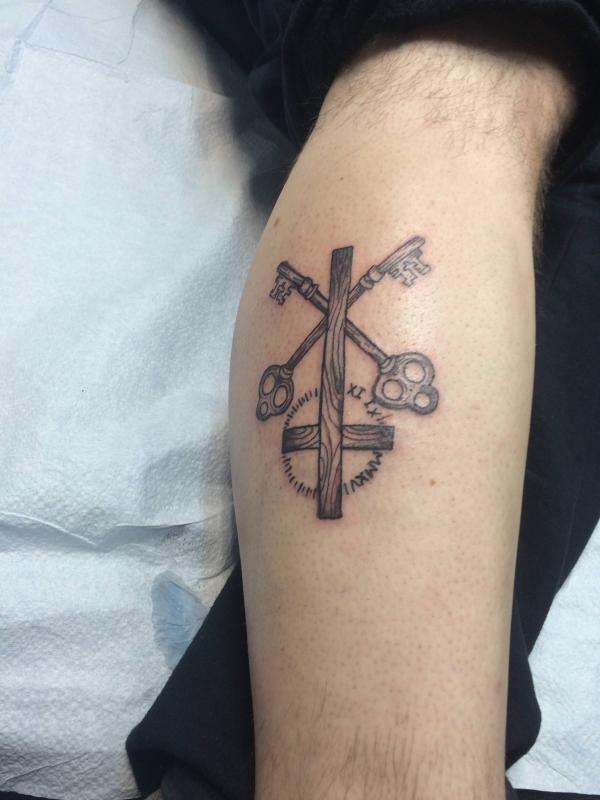
Christian Saints Tattoos
Christianity boasts a vast tapestry of symbols, each with its own tale of faith, courage, and miracles. Among these are the saints—men and women whose lives of devotion and trials continue to inspire the faithful. Tattoos of these saints serve as permanent reminders and personal icons for believers, each inked image a silent prayer, a guide, a protector.
Saint Andrew
The X-shaped cross, also called the Saltire or St. Andrew’s Cross, is often used to represent Saint Andrew, who is the patron saint of Scotland and one of Jesus’ twelve disciples. Tattoos of this symbol represent willingness to embrace suffering for one’s beliefs. The Saltire Cross is a sign of power and conviction. It is also a reminder of Andrew’s death and a testimony to the Christian faith.
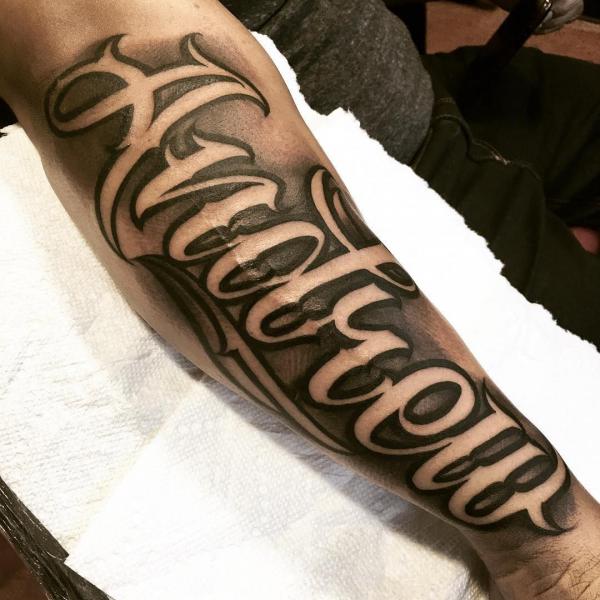
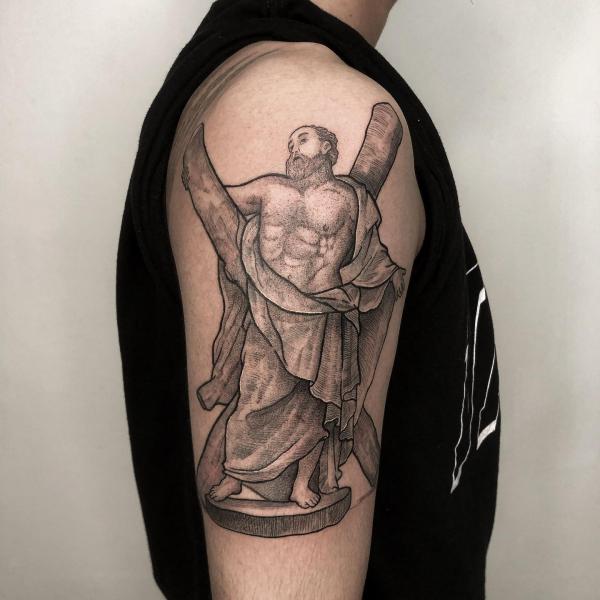
Saint Florian
Saint Florian, a Roman soldier and firefighter, is synonymous with protection against fire and danger. A tattoo of Saint Florian often includes his image pouring water to extinguish flames, a symbol of courage and protection. Firefighters and those seeking safeguarding from harm frequently bear his likeness as a talisman against the elements.
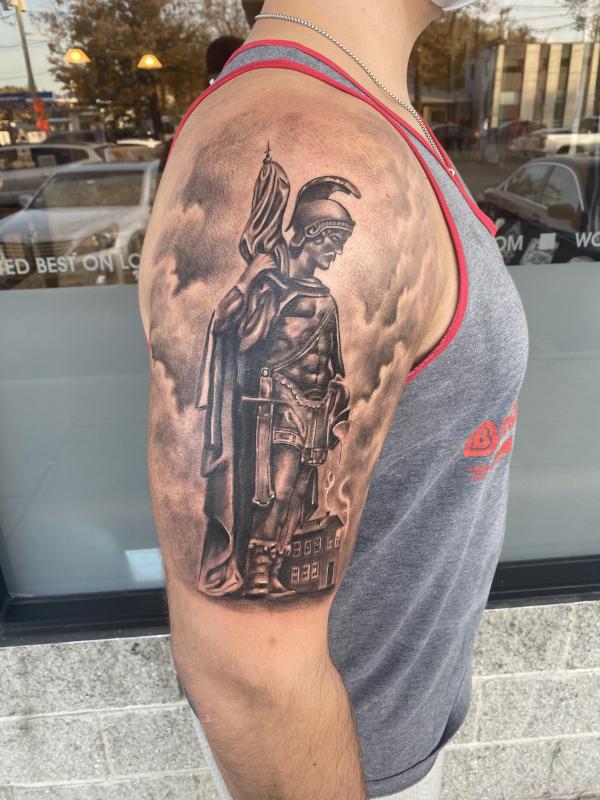
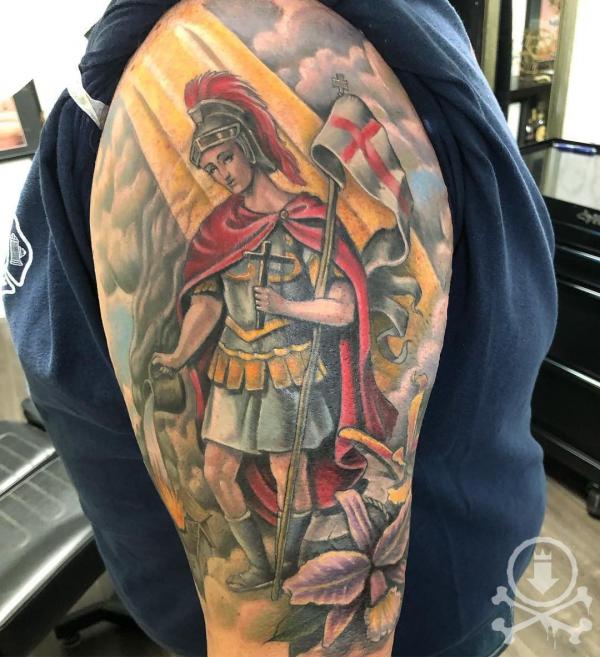
Saint Gabriel
As the messenger of God, Saint Gabriel tattoos are teeming with symbolism. Often shown with a trumpet, these tattoos symbolize clarity, truth, and the announcement of significant life events. Those who choose Saint Gabriel’s image often seek to channel his role as a divine messenger, carrying forth messages of hope and inspiration.
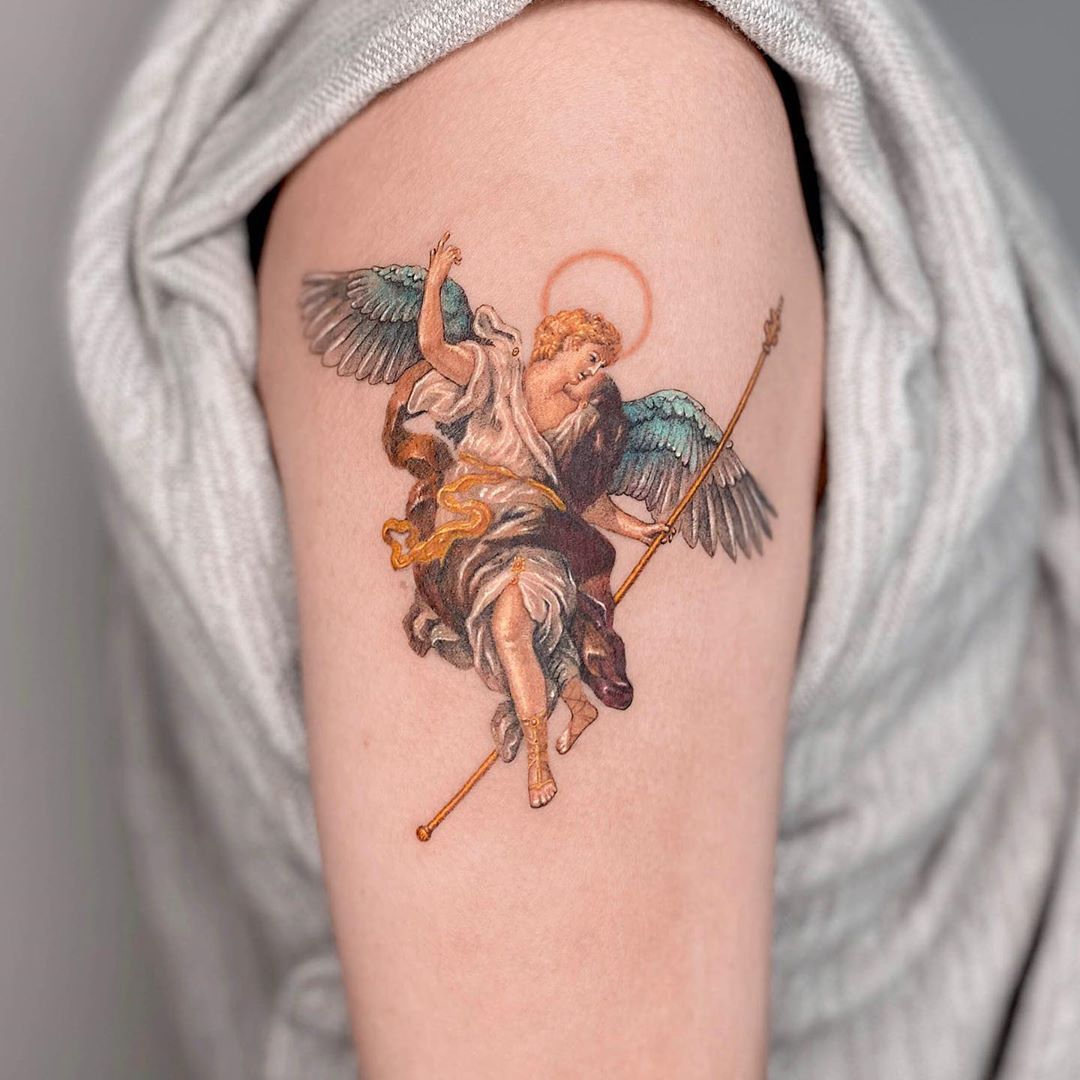
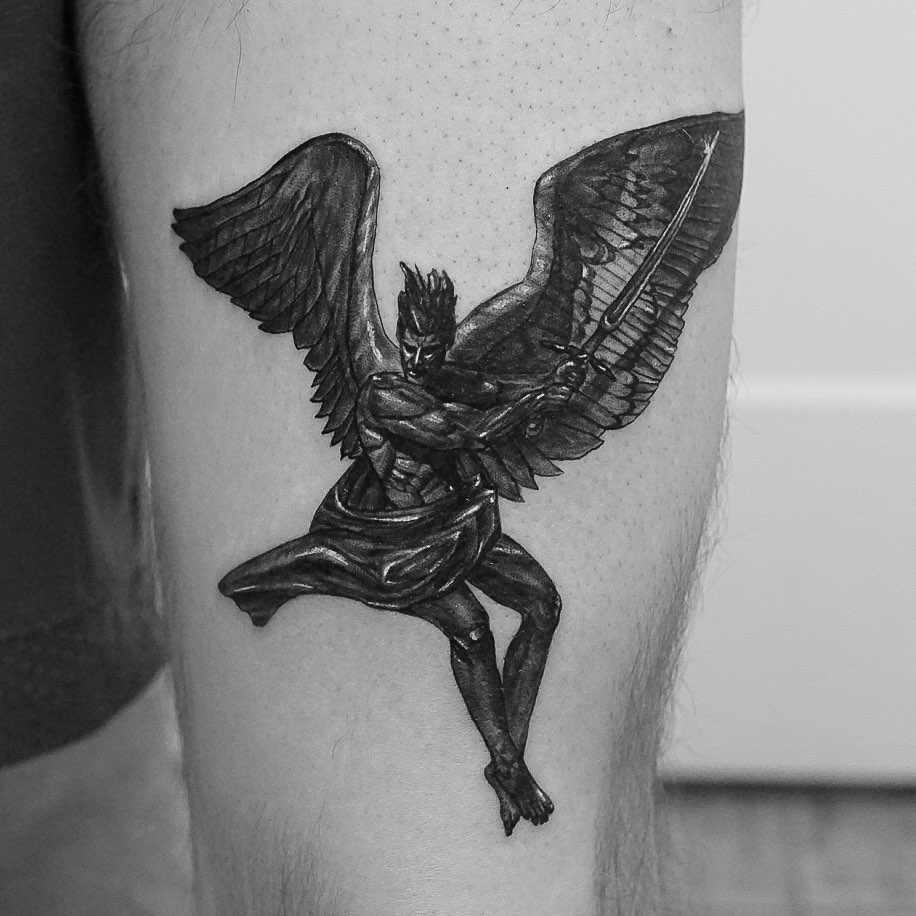
Saint George and the Dragon
Saint George’s legendary battle with the dragon is a narrative of good conquering evil, making it a popular tattoo choice. The image of Saint George, armored and victorious over the dragon, is a powerful symbol of overcoming adversity. It’s a visual battle cry, a declaration of one’s inner strength and the will to conquer one’s own dragons.
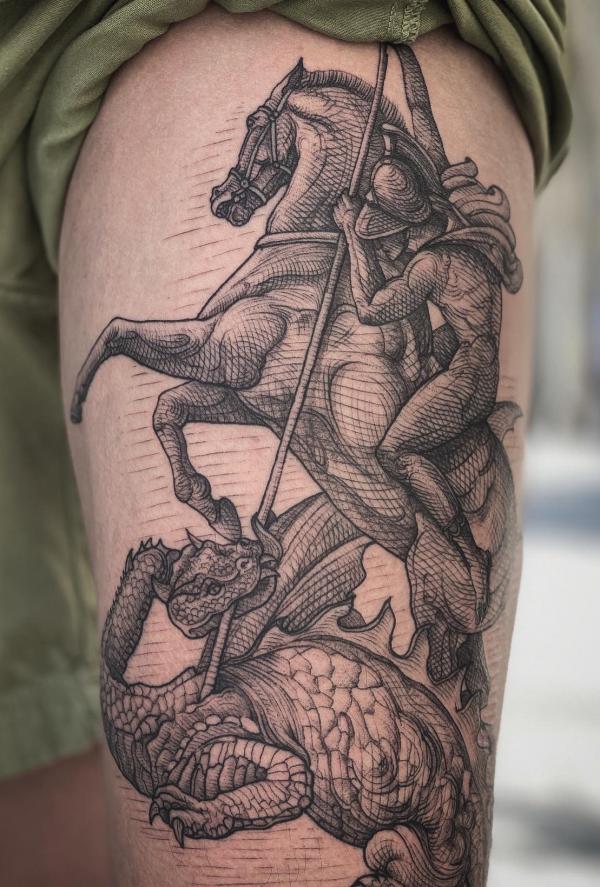
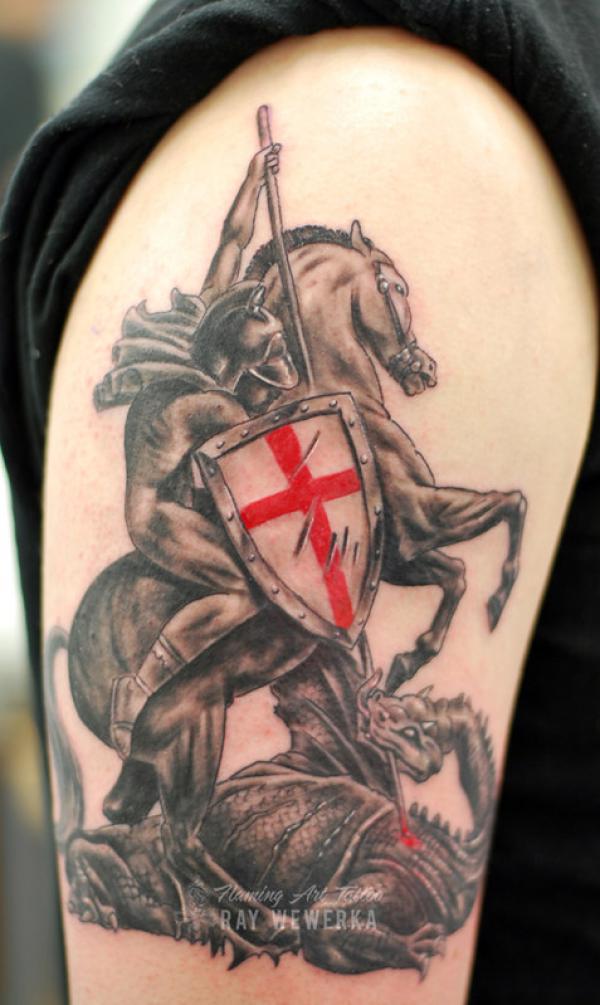
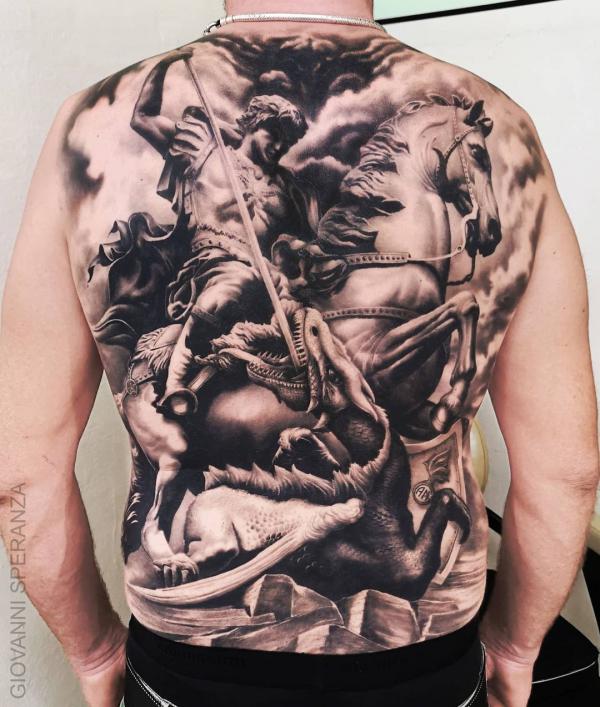
Saint Michael
The Archangel Michael, leader of the army of God, is a dominant figure inked across the skin of many believers. His depiction usually includes armor and a sword, standing triumphantly over a vanquished devil. Saint Michael tattoos represent protection, good prevailing over evil, and spiritual warfare. For those who bear his image, it’s a badge of honor, a sign of a warrior’s spirit.
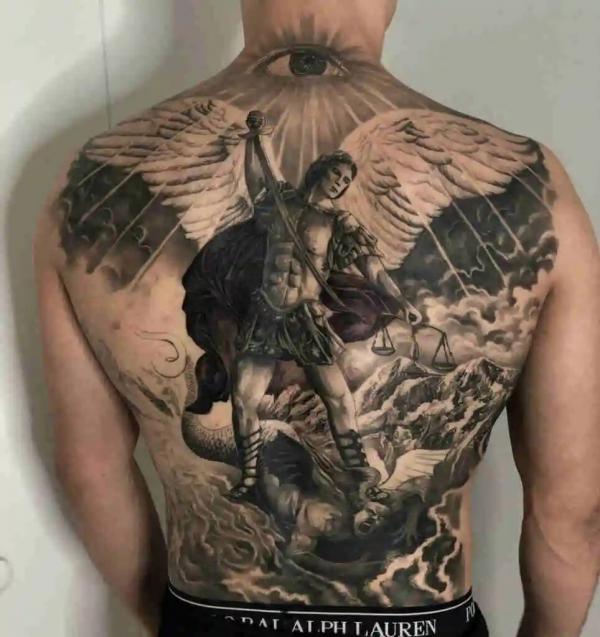
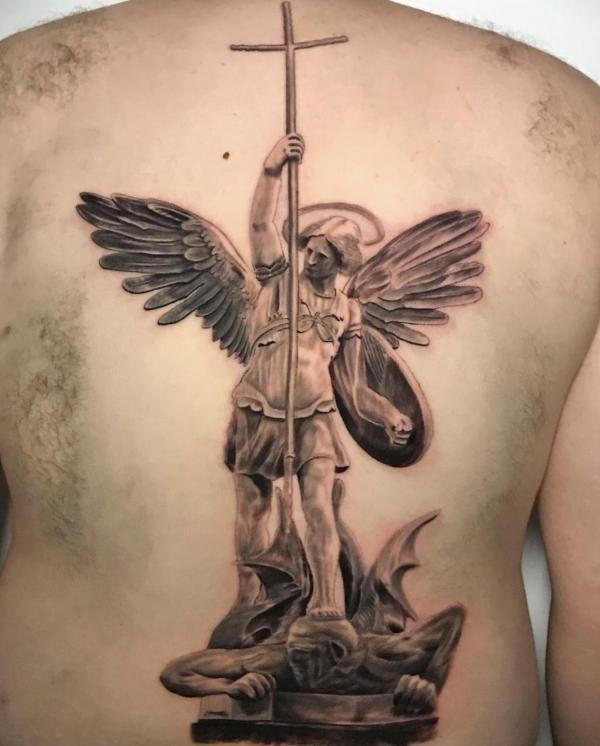
Saint Paul
Saint Paul, once a persecutor of Christians, converted and became one of the most influential apostles. His tattoos often depict him with a sword, representing the “Sword of the Spirit,” which is the word of God. Bearing Saint Paul’s image is a testament to transformation, a commitment to spreading the gospel, and an acknowledgment of the power of redemption.
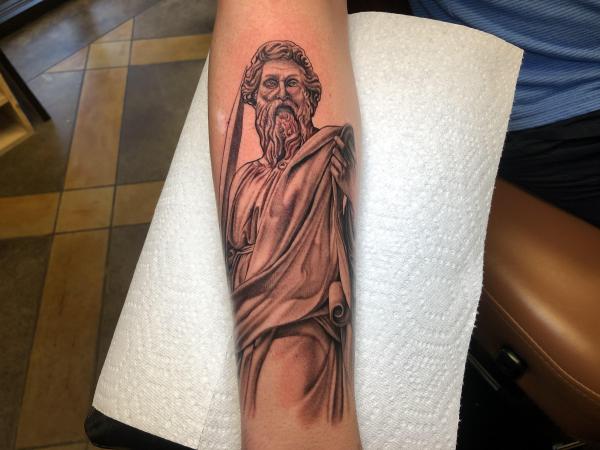
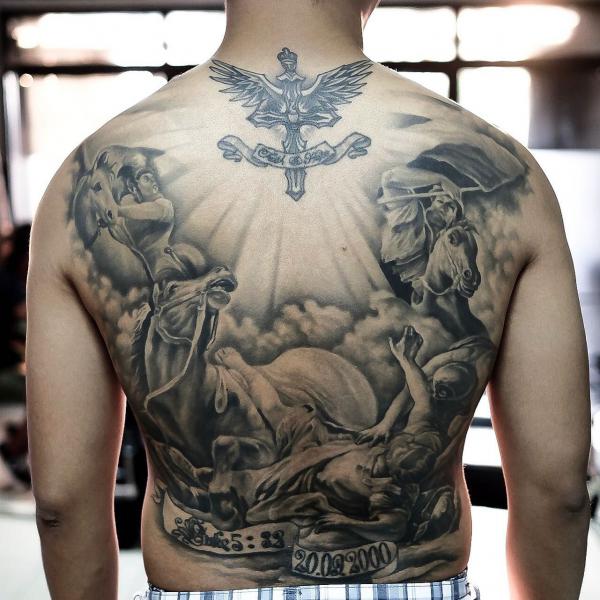
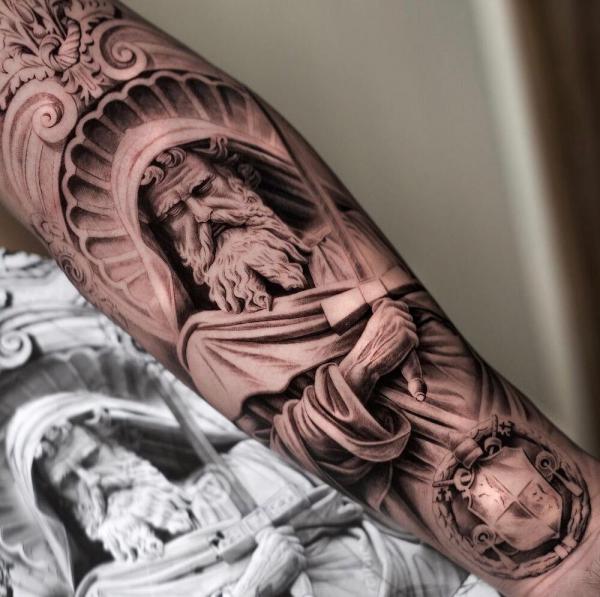
Saint Peter
The apostle Peter, recognized as the rock upon which the Church was built, is a symbol of unwavering faith. Tattoos of Saint Peter often feature keys, signifying the keys to Heaven given by Jesus. A Saint Peter tattoo is a nod to spiritual authority and the belief in the binding and loosing power of the church.
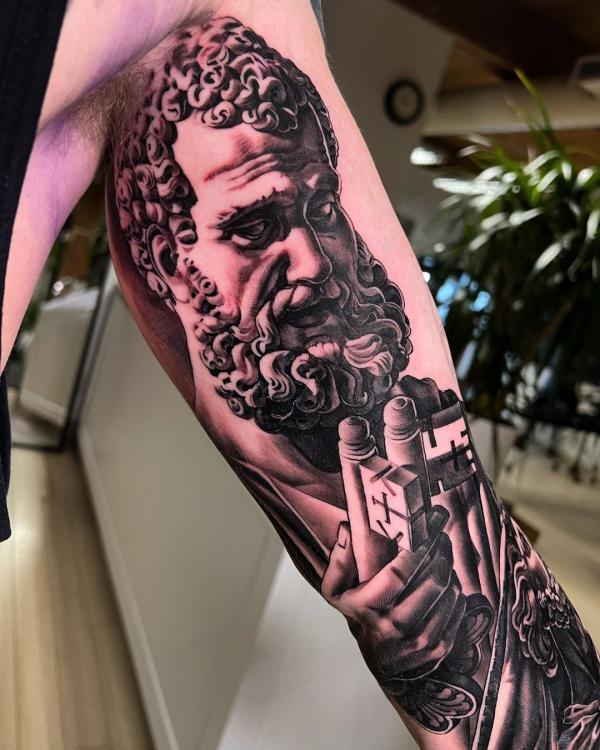
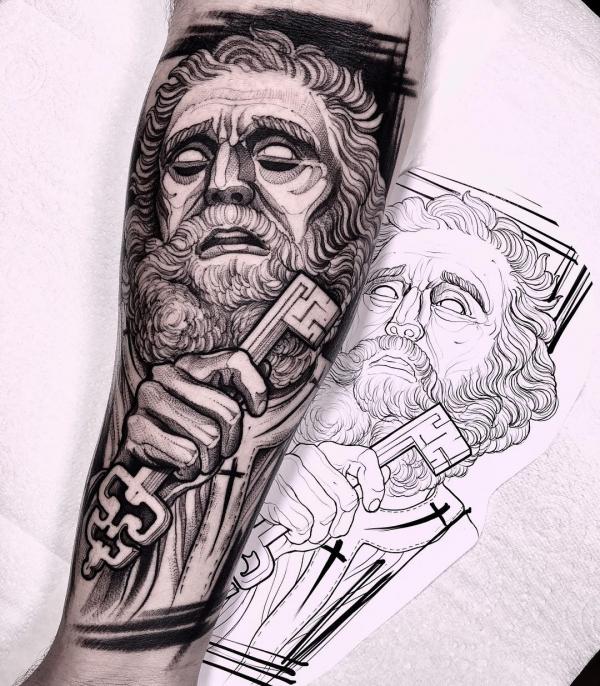
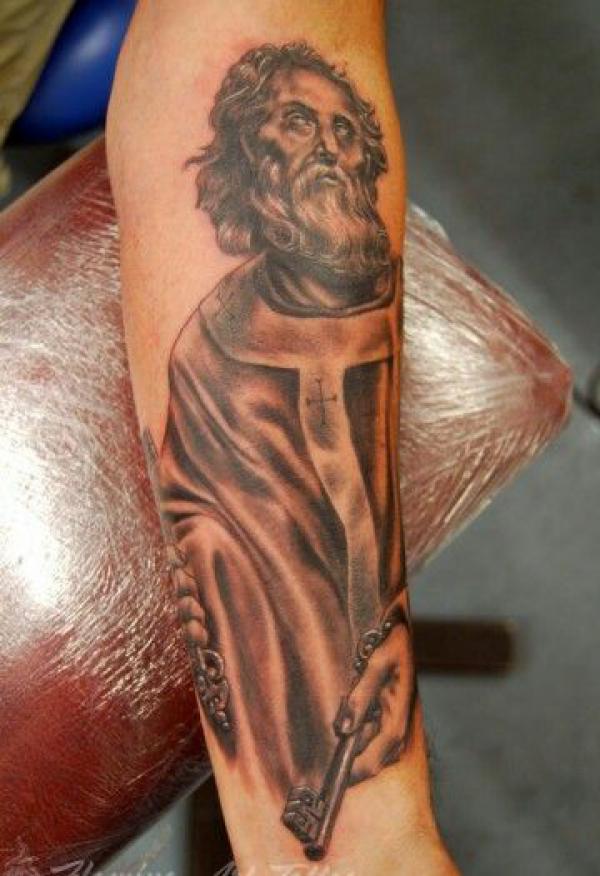
Saint Theresa of Avila
Saint Theresa of Avila, a mystic and reformer, is famous for her writings on the soul’s journey to God. Tattoos inspired by her often include imagery of a castle or a heart pierced by an arrow, denoting her mystical experiences and the journey of spiritual ascension. Carrying her image in ink speaks to the wearer’s quest for spiritual depth and enlightenment.
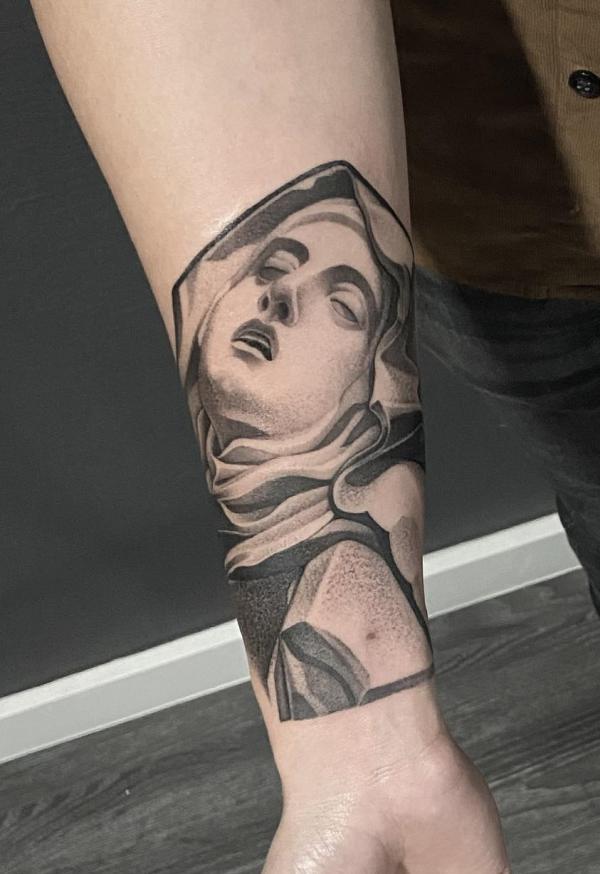
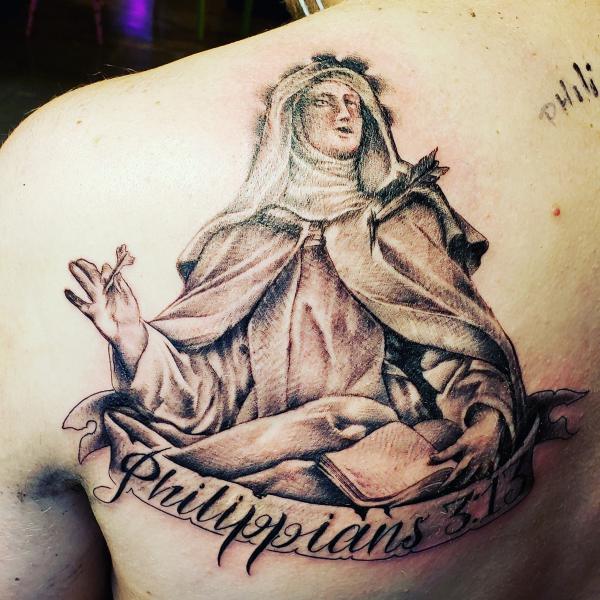
San Judas Tattoos
San Judas, or Saint Jude, is the patron saint of lost causes and desperate situations. Tattoos of San Judas often show him holding an image of Jesus, a symbol of his close relationship with Christ. For those feeling lost or in despair, a San Judas tattoo is a beacon of hope, a reminder that no cause is ever truly lost.
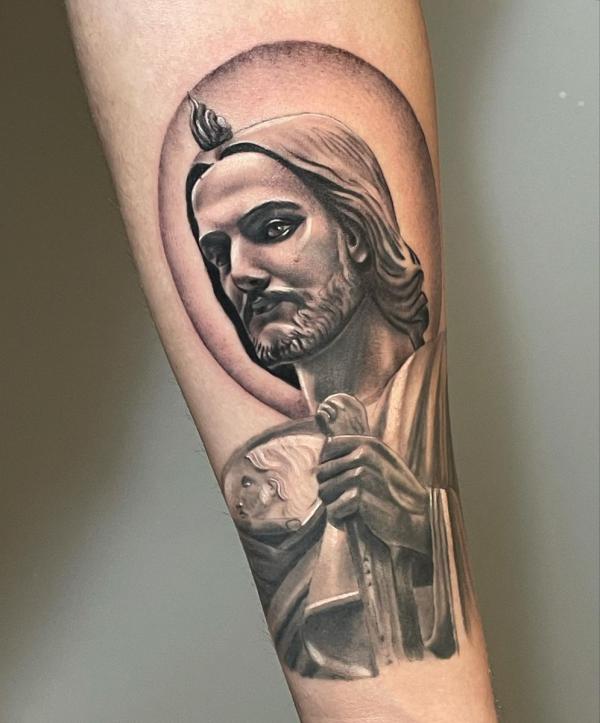
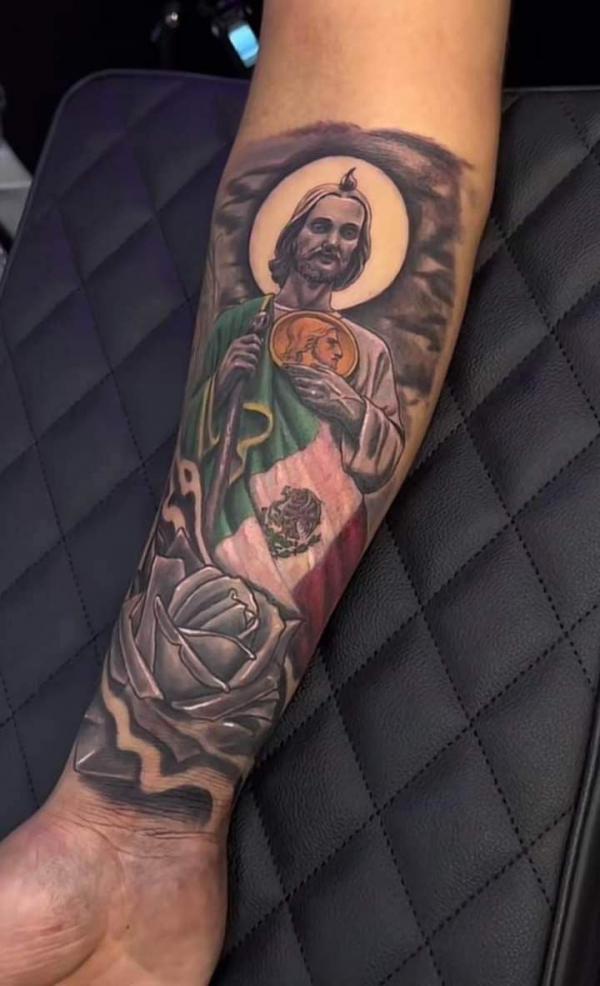
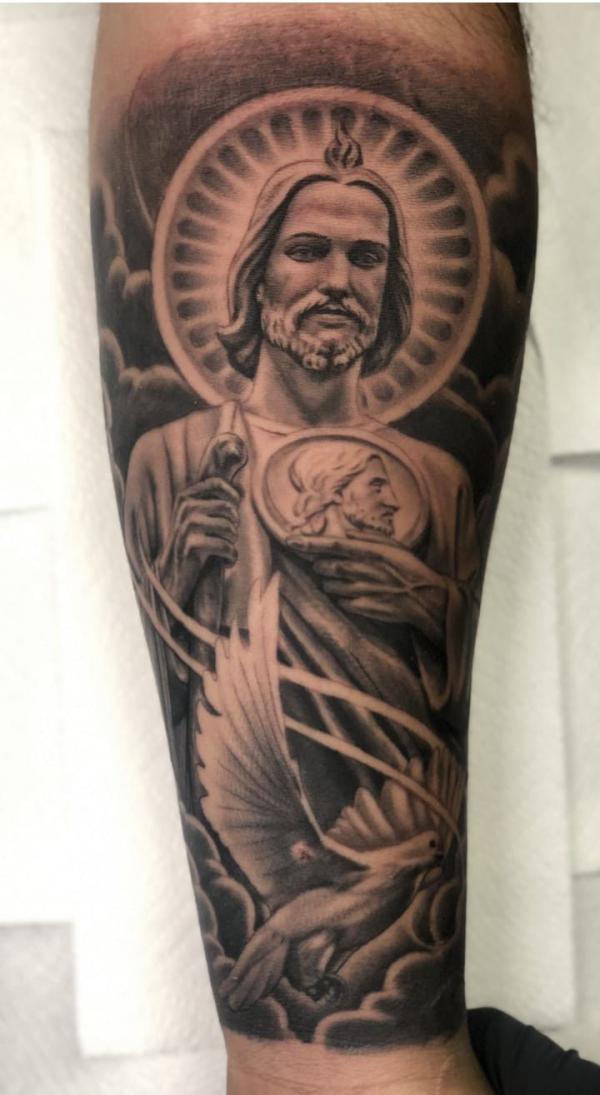
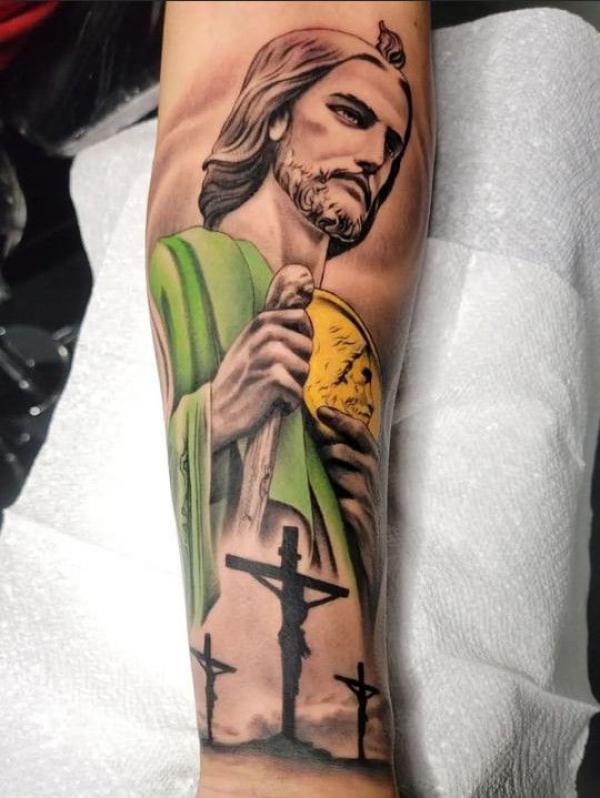
Saint Rita of Cascia Tattoo
Saint Rita is revered for her patient suffering, her unwavering faith in the face of impossible circumstances, and her prayers for intercession. Tattoos of Saint Rita often include roses or a thorn, reminiscent of her miraculous experiences. Bearing her image is an appeal for perseverance and faith when faced with insurmountable challenges.
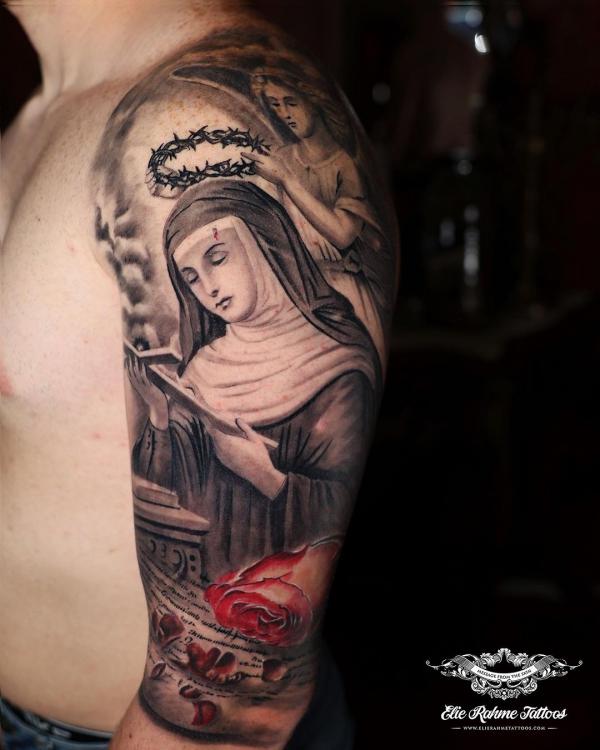
Saint Jerome Statue Tattoo
Saint Jerome, best known for translating the Bible into Latin (the Vulgate), is a symbol of scholarship and asceticism. Tattoos depicting Saint Jerome as a statue often include a lion, a reference to the legend of him taming one. Scholars, theologians, and those dedicated to the study of scripture may choose his likeness as a symbol of intellectual pursuit and devotion to learning.
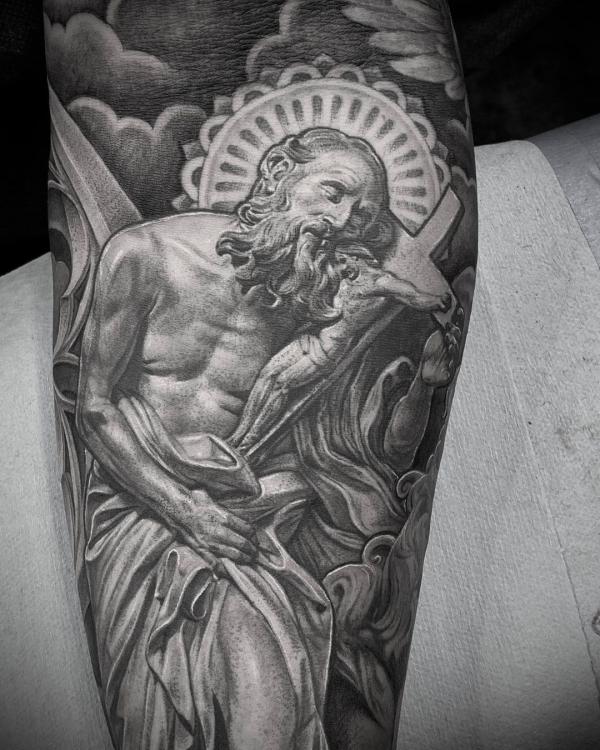
Other Christian Religious Imagery Tattoos
Christian religious imagery tattoos are particularly evocative, embodying rich symbolism and deep spiritual significance. From protective cherubs to the venerated Virgin Mary, each design encapsulates a story, a prayer, or a piece of theological heritage.
Cherub
Cherub tattoos are a delightful nod to the celestial. These angelic beings, often depicted as innocent children with wings, symbolize purity, love, and a protective presence. Ink enthusiasts who choose cherubs typically seek to capture the joy and guardianship they represent. These tattoos serve as a reminder of divine oversight and the lighter, more hopeful aspects of faith. They’re not just charming—they’re a visual hymn to the guardian angels believed to watch over humanity.
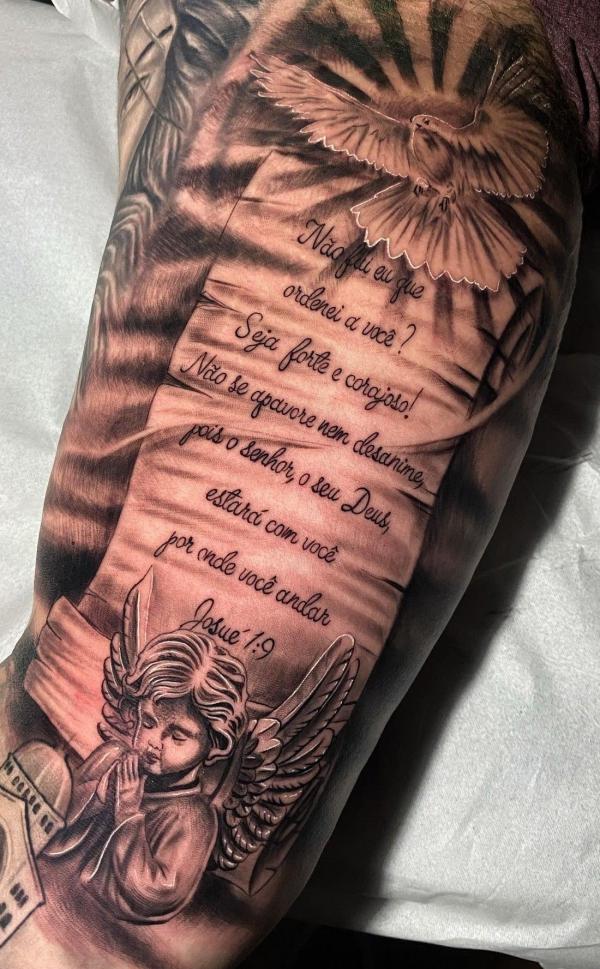
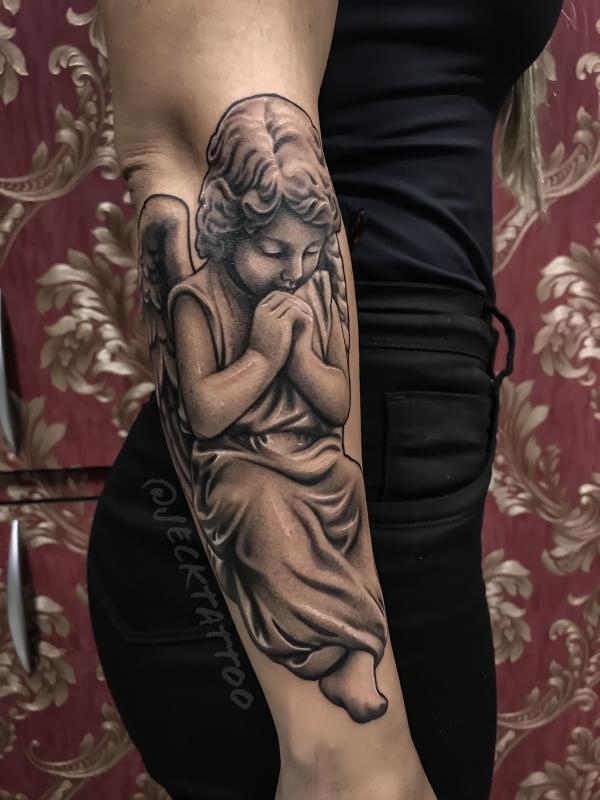
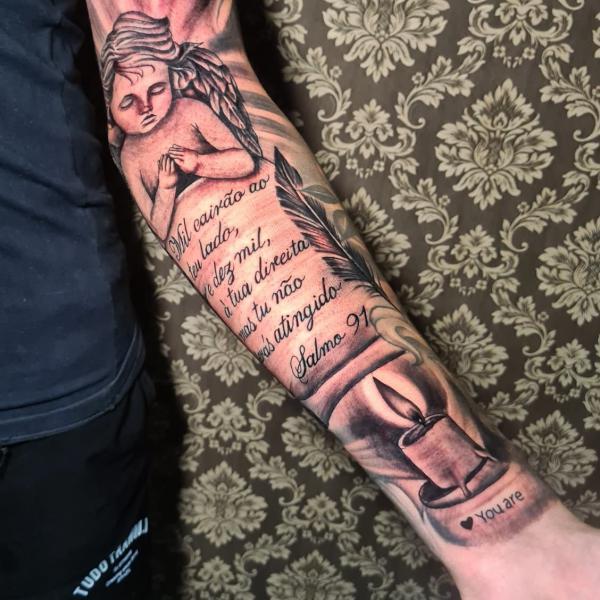
Crusader Christian Tattoos
The imagery of Crusader tattoos harks back to a tumultuous era of knights and holy wars. These designs often feature the iconic Templar knights or the cross of St. George, emblems of chivalry and the Christian battle for faith. Wearers of these tattoos might be drawn to the symbolism of fighting for their beliefs, standing firm in the face of adversity, or upholding the virtues of bravery and sacrifice. In modern inking, these powerful symbols act as a personal coat of arms, a testament to the wearer’s spiritual and moral convictions.
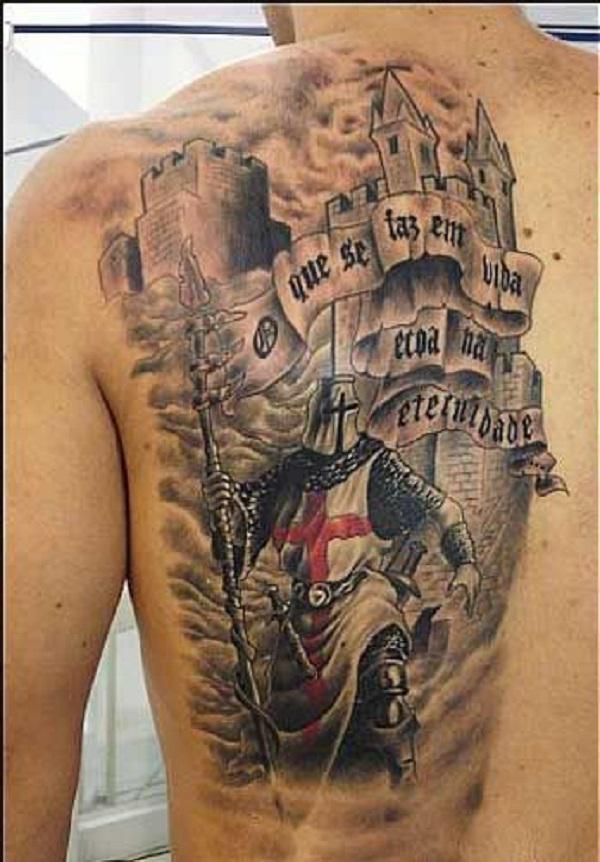
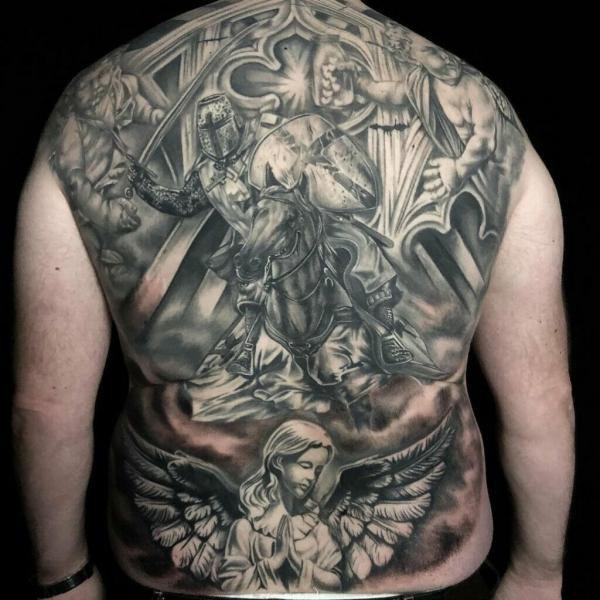
Santa Muerte Tattoos
Santa Muerte is a complex blend of Christian iconography and folk religion, predominantly found in Latin American cultures. This skeletal figure, often robed like the Virgin Mary, is a personification of death. While not officially recognized by the Church, Santa Muerte holds a significant place in the hearts of many believers. Tattoos of this figure are thought to provide protection, healing, and safe passage in the afterlife. They embody a raw, unfiltered acknowledgment of life’s finality and the hope for something beyond.
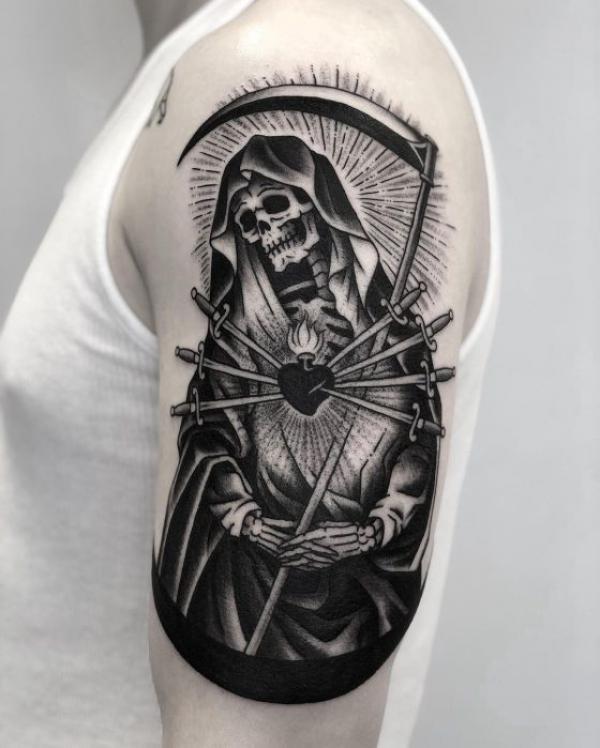
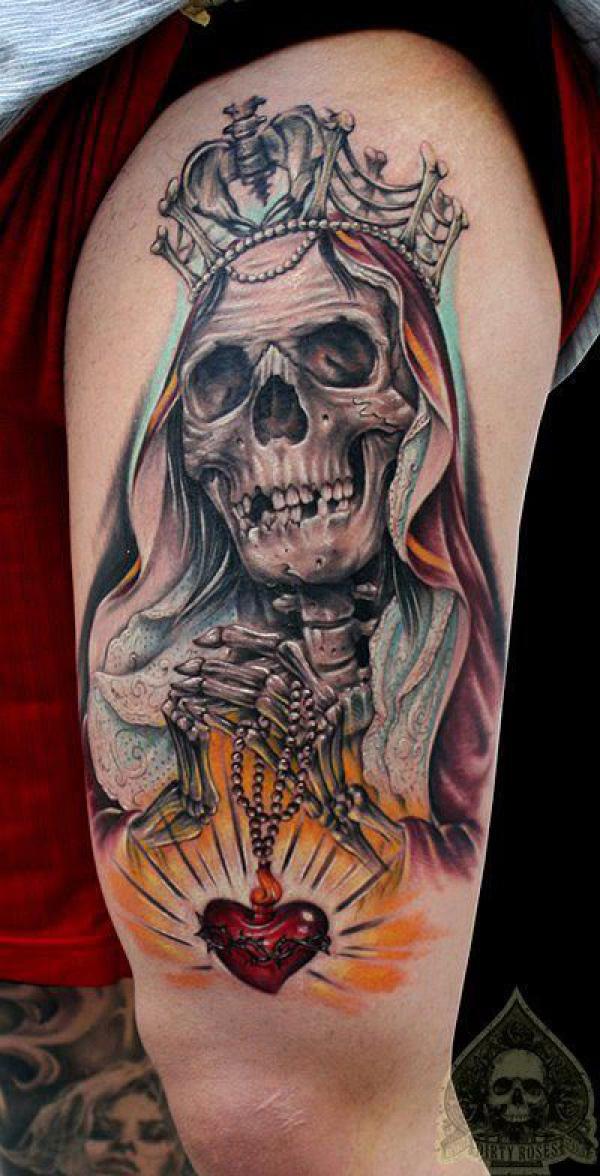
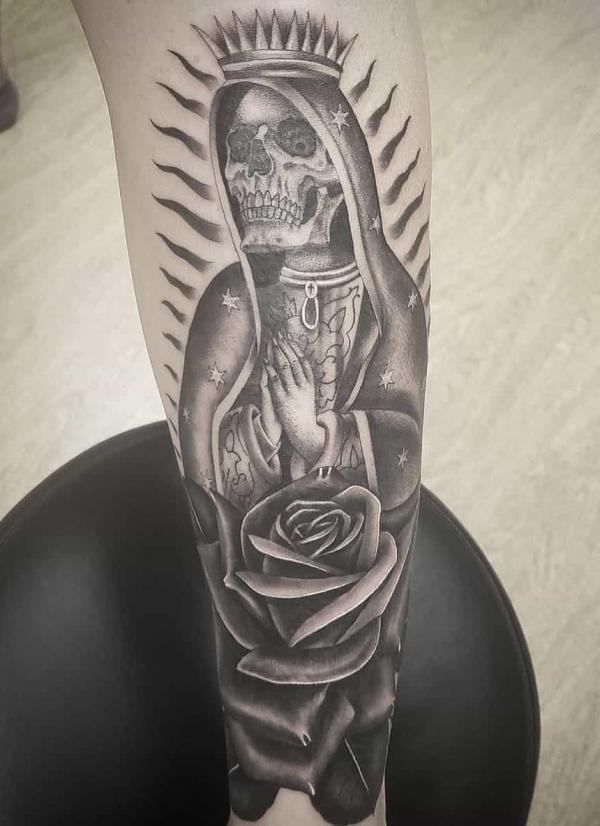
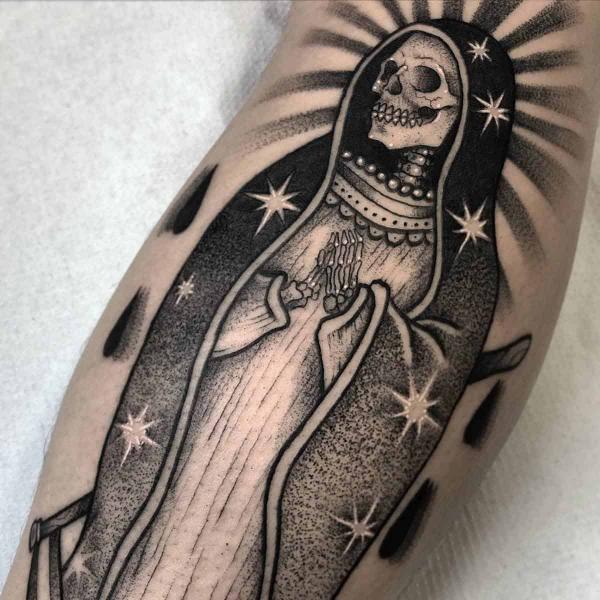
The Fall of the Rebel Angels Tattoo
The Fall of the Rebel Angels tattoo is a depiction of the ultimate spiritual conflict—the expulsion of Lucifer and his followers from Heaven. This dramatic scene, often inspired by classical art, serves as a powerful reminder of the triumph of good over evil. It’s an epic narrative captured in ink, a permanent representation of the cosmic battle and divine justice. Those who wear this design may feel aligned with the forces of light, showcasing their own inner strength and resolve against life’s temptations and turmoil.
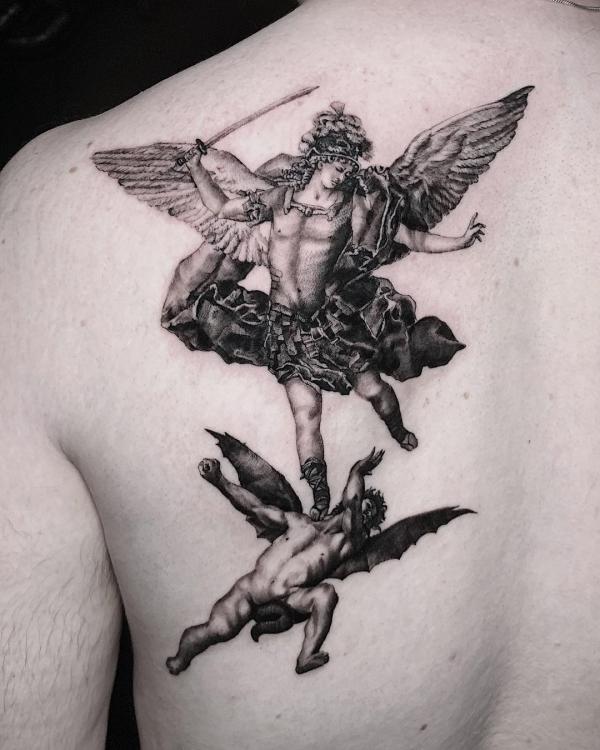
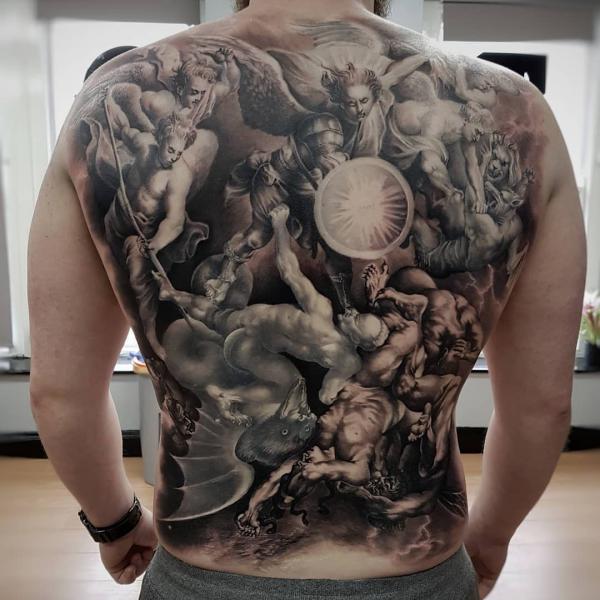
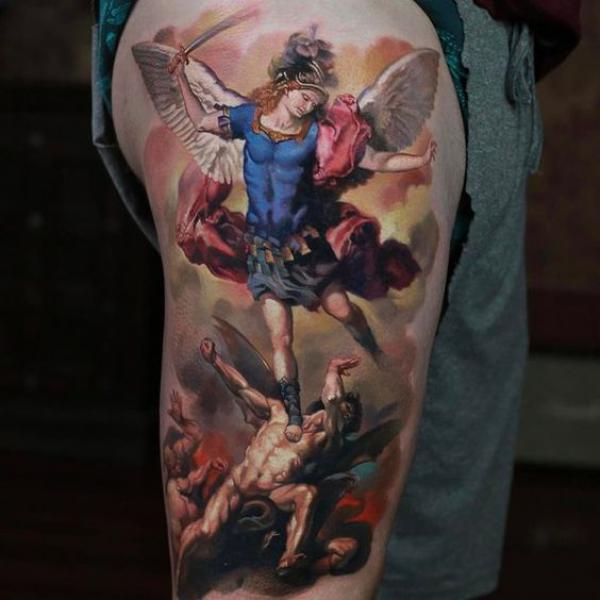
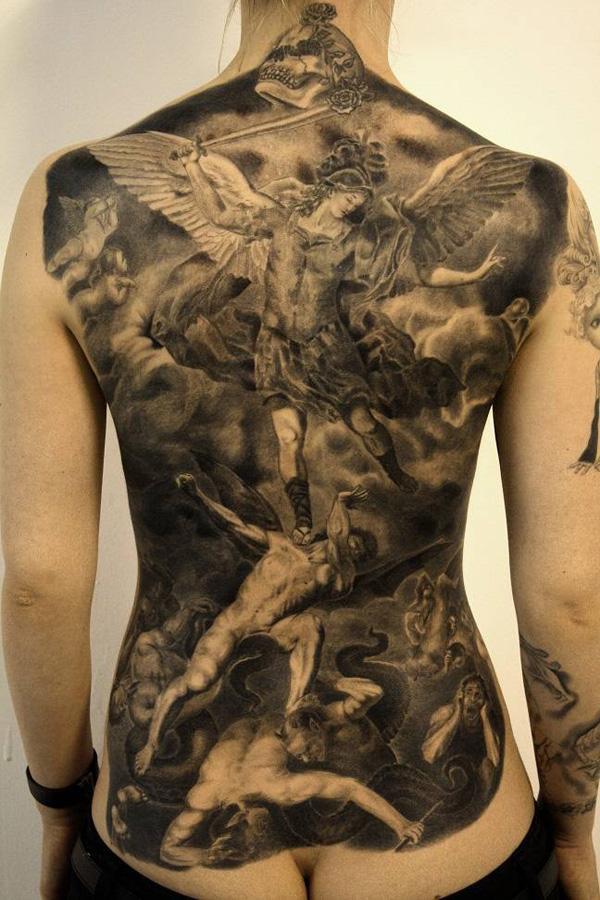
A Tapestry of Testimonies
Christian tattoos are more than just adornments; they are woven into the very fabric of the wearer’s life story. They speak of personal struggles, triumphs, and the sustaining power of faith. Each tattoo tells a unique tale, a visual testimony to a journey of belief, transformation, and renewal.
Symbols of Protection and Guidance
For some, Christian tattoos are akin to spiritual armor, marks of divine protection in a world that can often feel threatening. They are silent prayers for guidance, with angels, St. Michael the Archangel, or patron saints standing guard over the flesh.
Memorials and Remembrances
A Christian tattoo can also serve as memorials, honoring loved ones who have passed on. These tattoos often incorporate elements of faith that were significant to the deceased, offering a way to keeptheir memory alive and connected to a shared belief in eternal life.
Artistic Expressions of the Divine
Christian tattoos often blend religious symbolism with artistic expression, resulting in breathtaking works of art that adorn the body like a sacred canvas. Each line, curve, and color chosen not only represents a facet of the wearer’s faith but also their aesthetic appreciation for the divine. Artists who specialize in religious tattoos frequently have a deepunderstanding of both the spiritual and artistic elements, creating designs that are both theologically meaningful and visually stunning.
The Diversity of Design
Within the Christian community, tattoos range from the traditional to the contemporary, from the minimalistic to the complex. Some prefer the age-old designs of crosses and saints rendered in black ink, echoing the stained glass and frescoes of ancient churches. Others opt for modern, abstract interpretations of Christian themes, blending styles and techniques to create something entirely new. The diversity of Christian tattoo artistry reflects the diversity of the faith itself, with each denomination and individual bringing their unique perspective to the table.
The Personal and the Universal
Christian tattoos sit at the intersection of personal experience and universal truth. A tattoo of the Good Shepherd is not just a portrayal of a biblical figure; it’s a personal statement about the wearer’s relationship with God. A depiction of the Last Supper is not merely a historical event; it’s a reflection on the meaning of community and sacrifice. These tattoos take the universal truths of Christianity and filter them through the prism of personal experience, creating a symbol that is both deeply private and widely resonant.
Conclusion
As the cultural stigma surrounding tattoos continues to fade, Christian tattoos are likely to become even more diverse and creative. They are a living tradition, one that adapts to the times while remaining rooted in the timeless truths of Christianity. The future of Christian tattoos is a canvas yet to be filled, promising new expressions of age-old beliefs.
Ink and faith blend seamlessly in the world of Christian tattoos. These marks are far more than skin deep; they are emblems of a faith that is written on the heart and lived out in the flesh. A Christian tattoo is a visual language, a way to communicate the incommunicable mysteries of the divine. For those who bear them, they are signposts of the soul, guiding them on the path towards the eternal.

